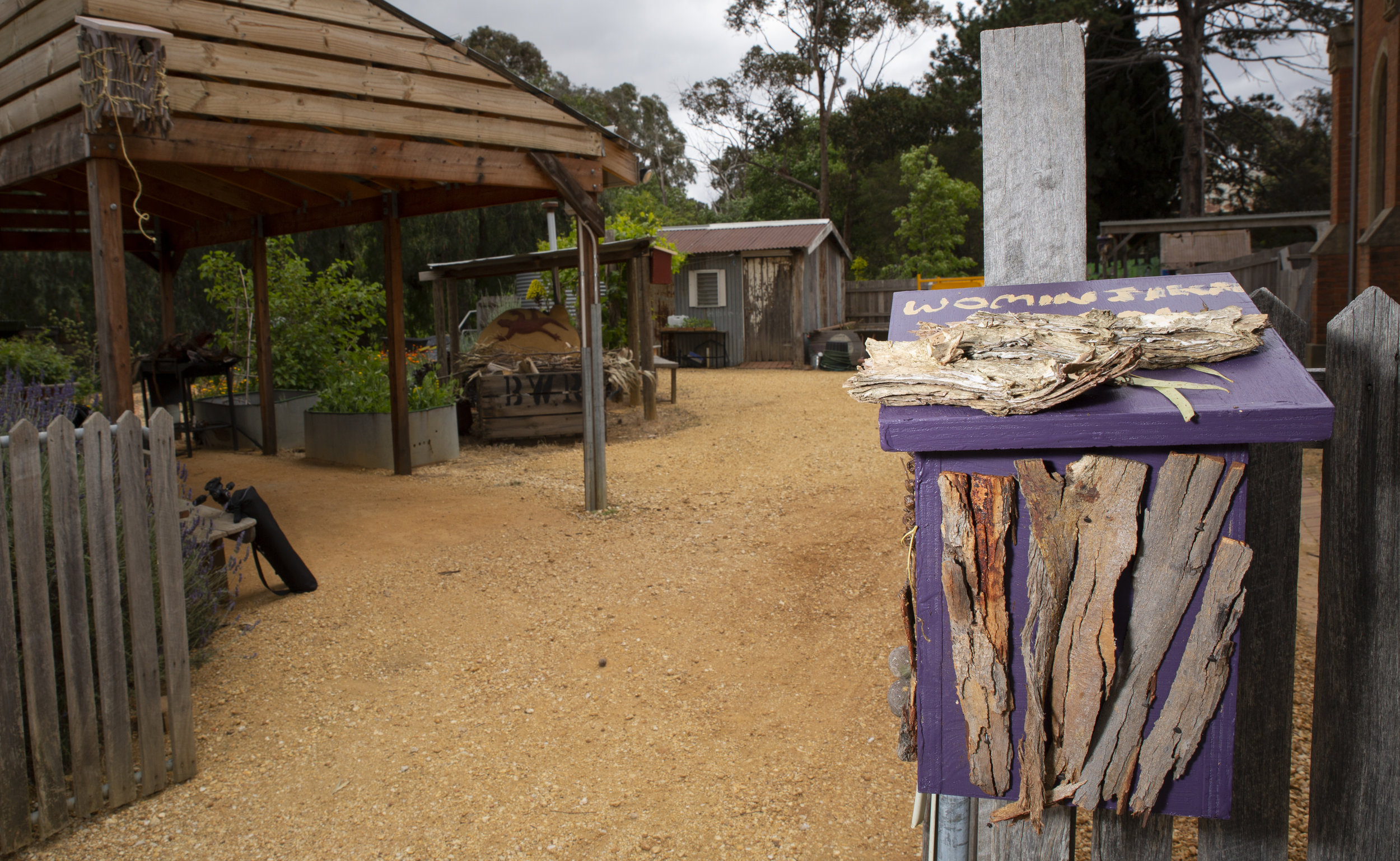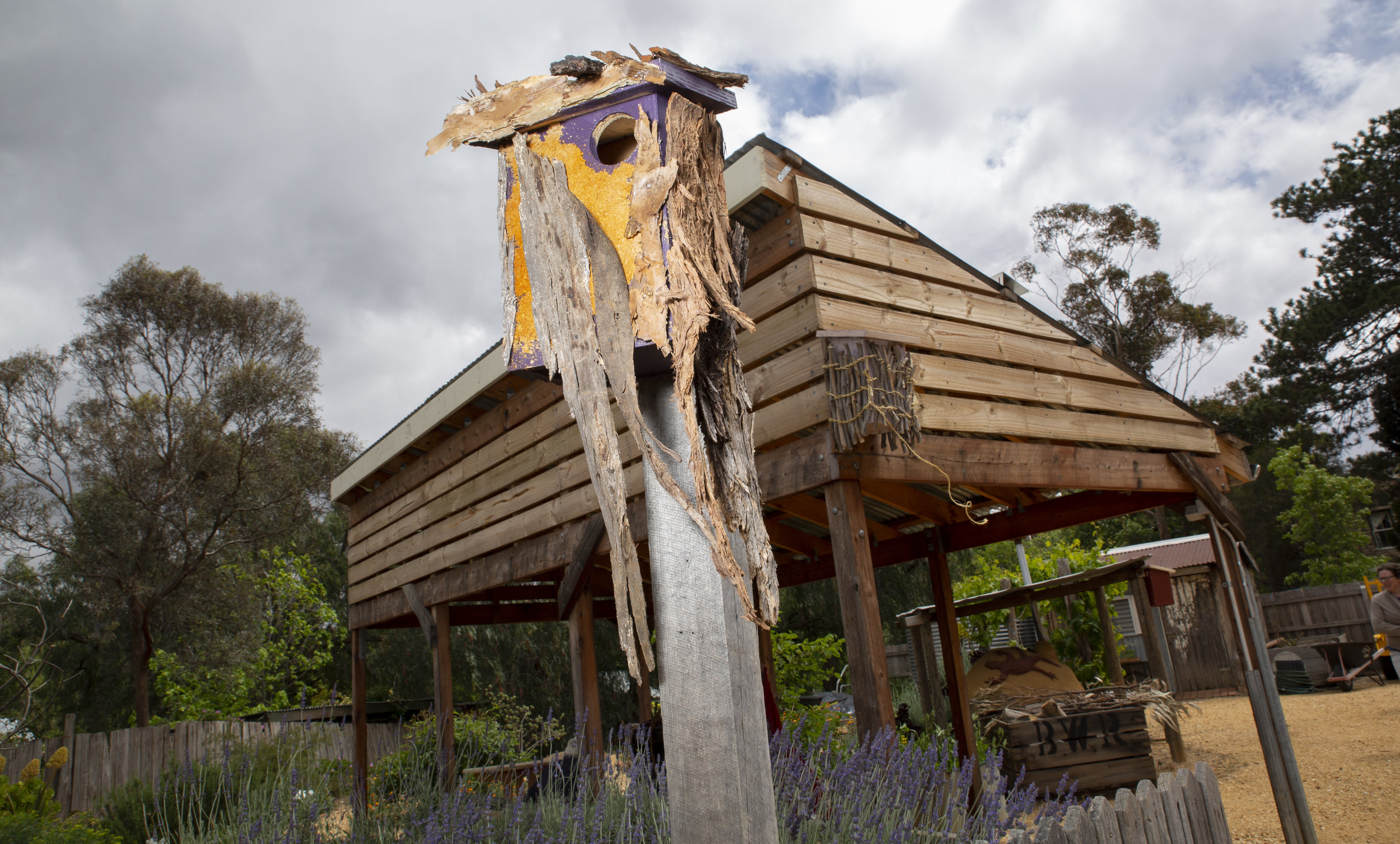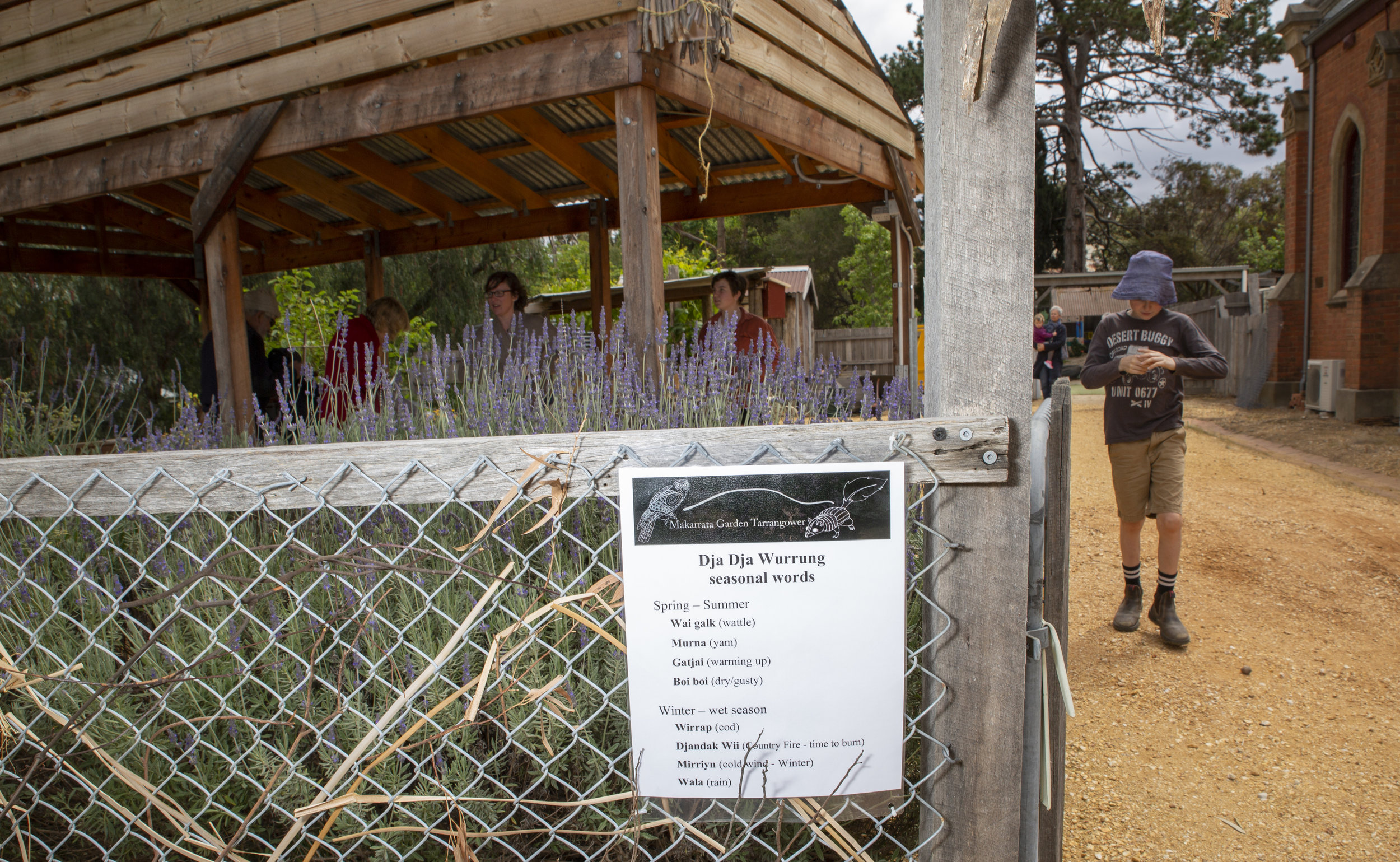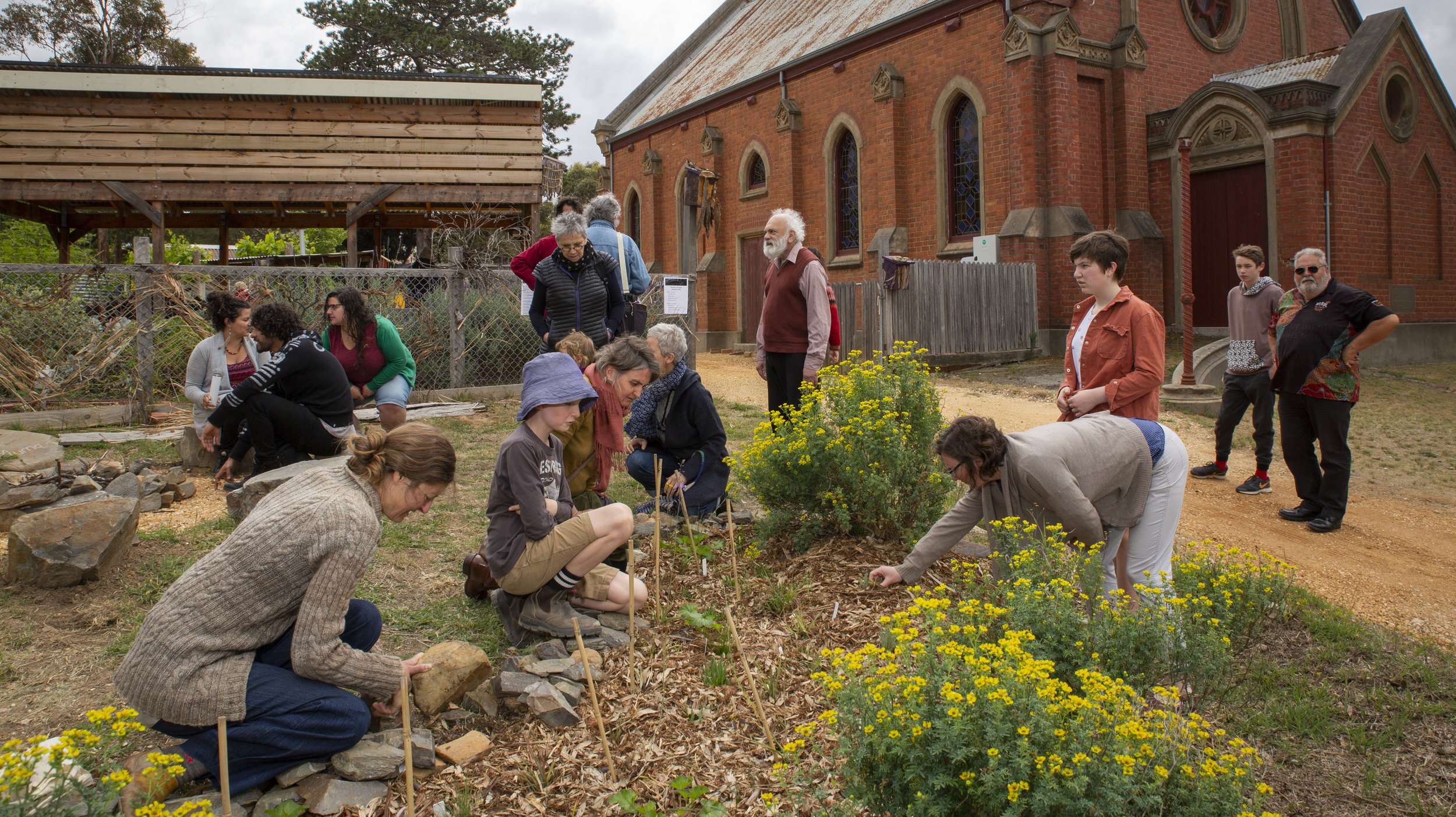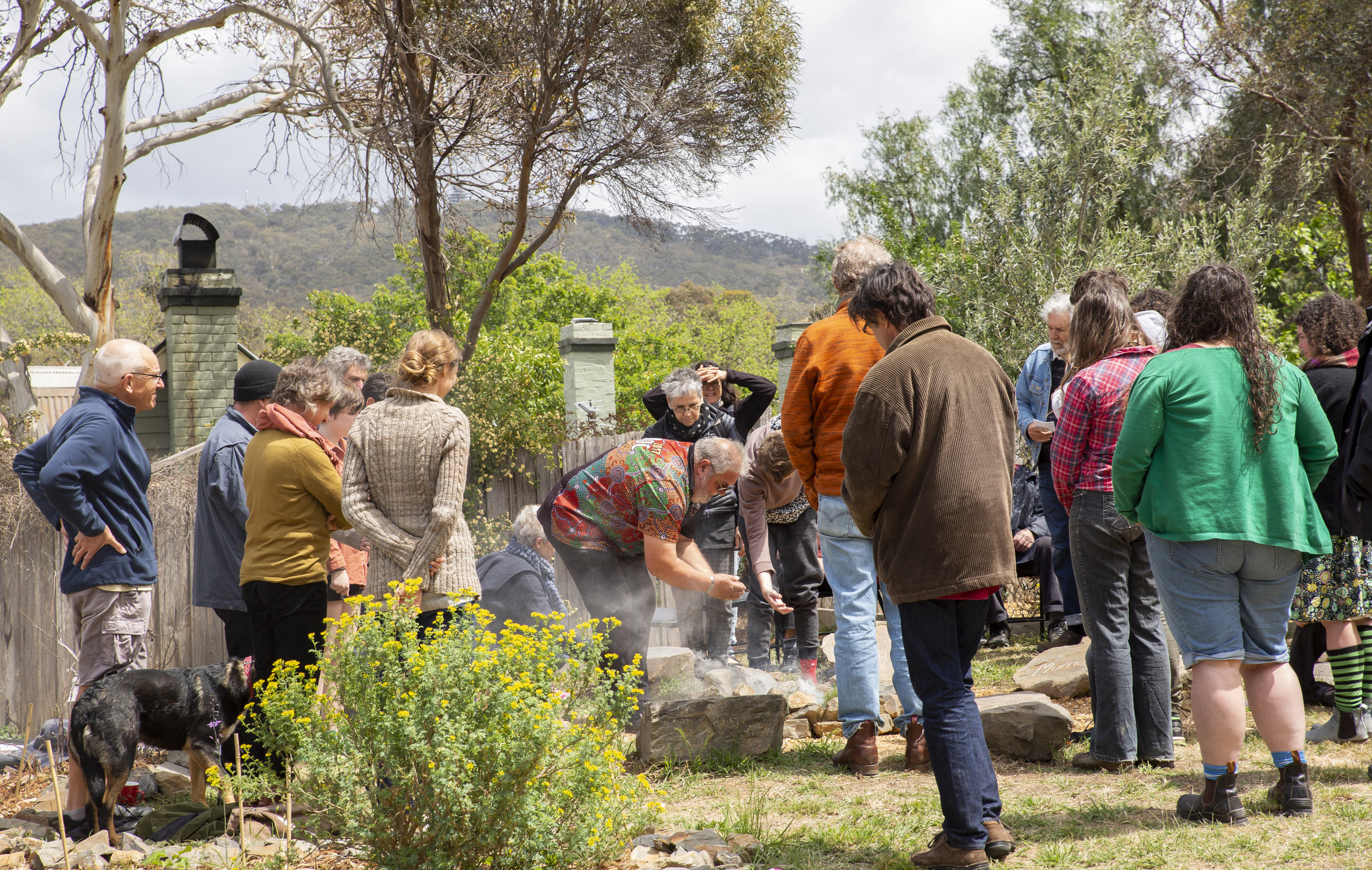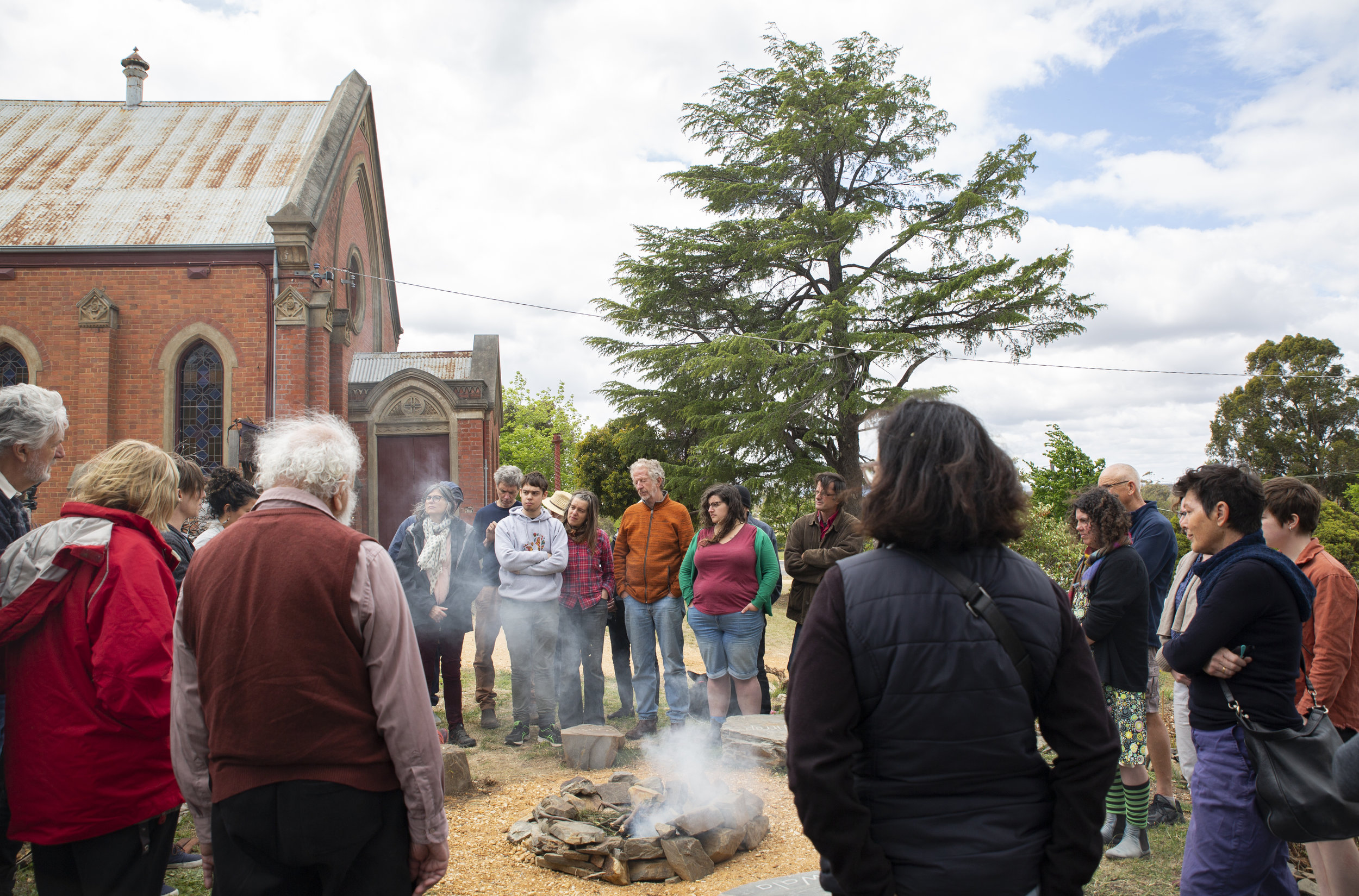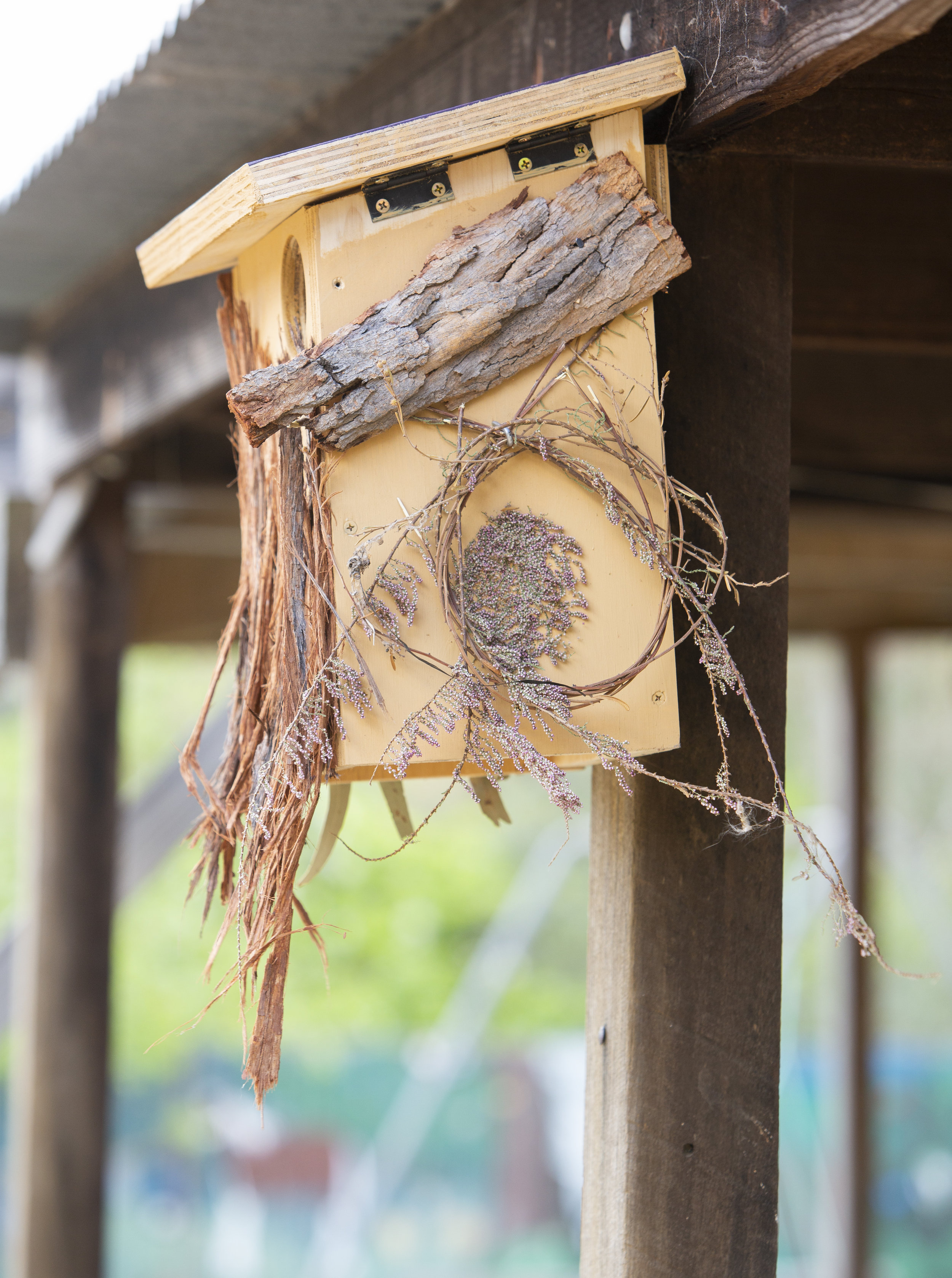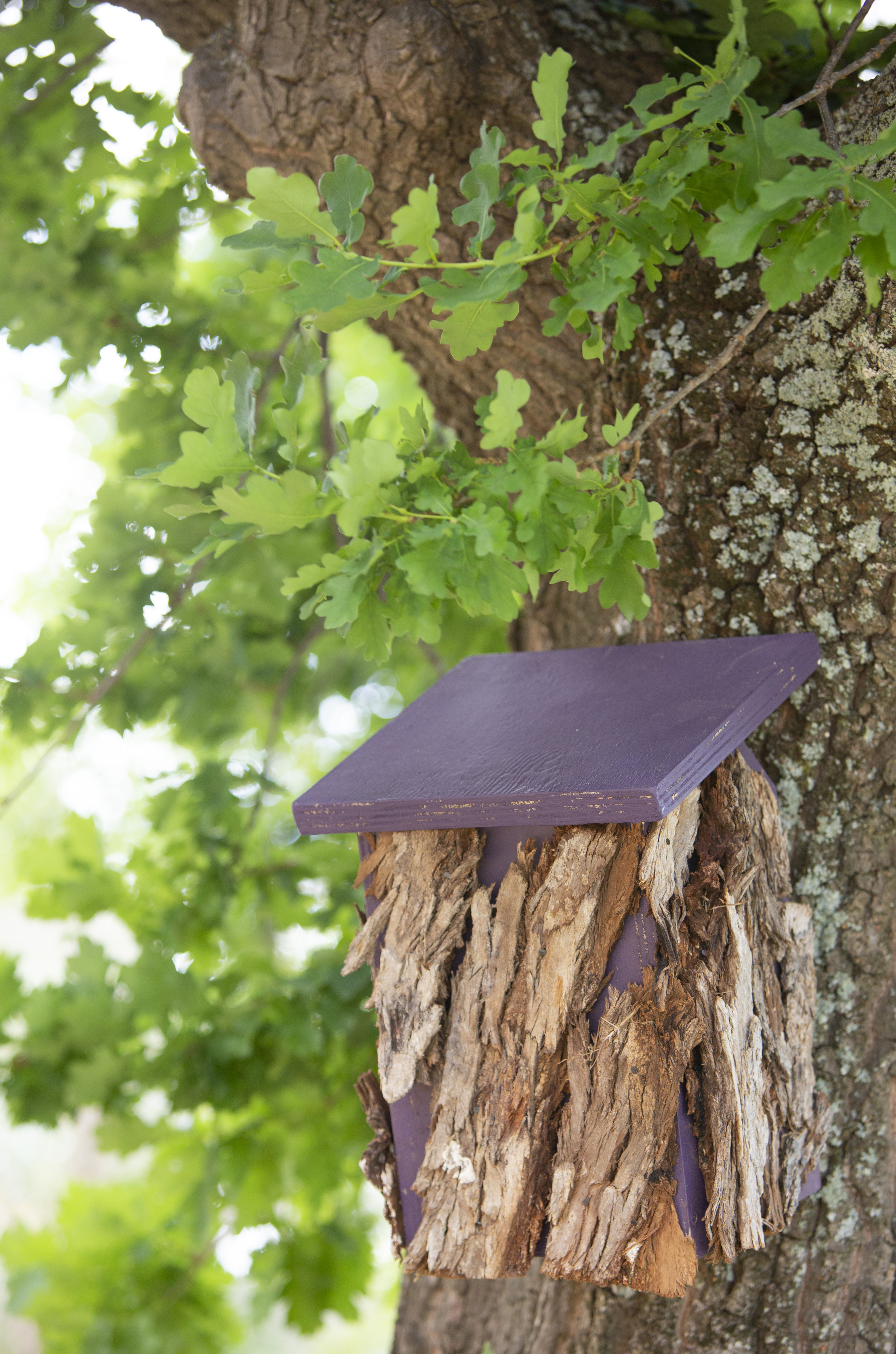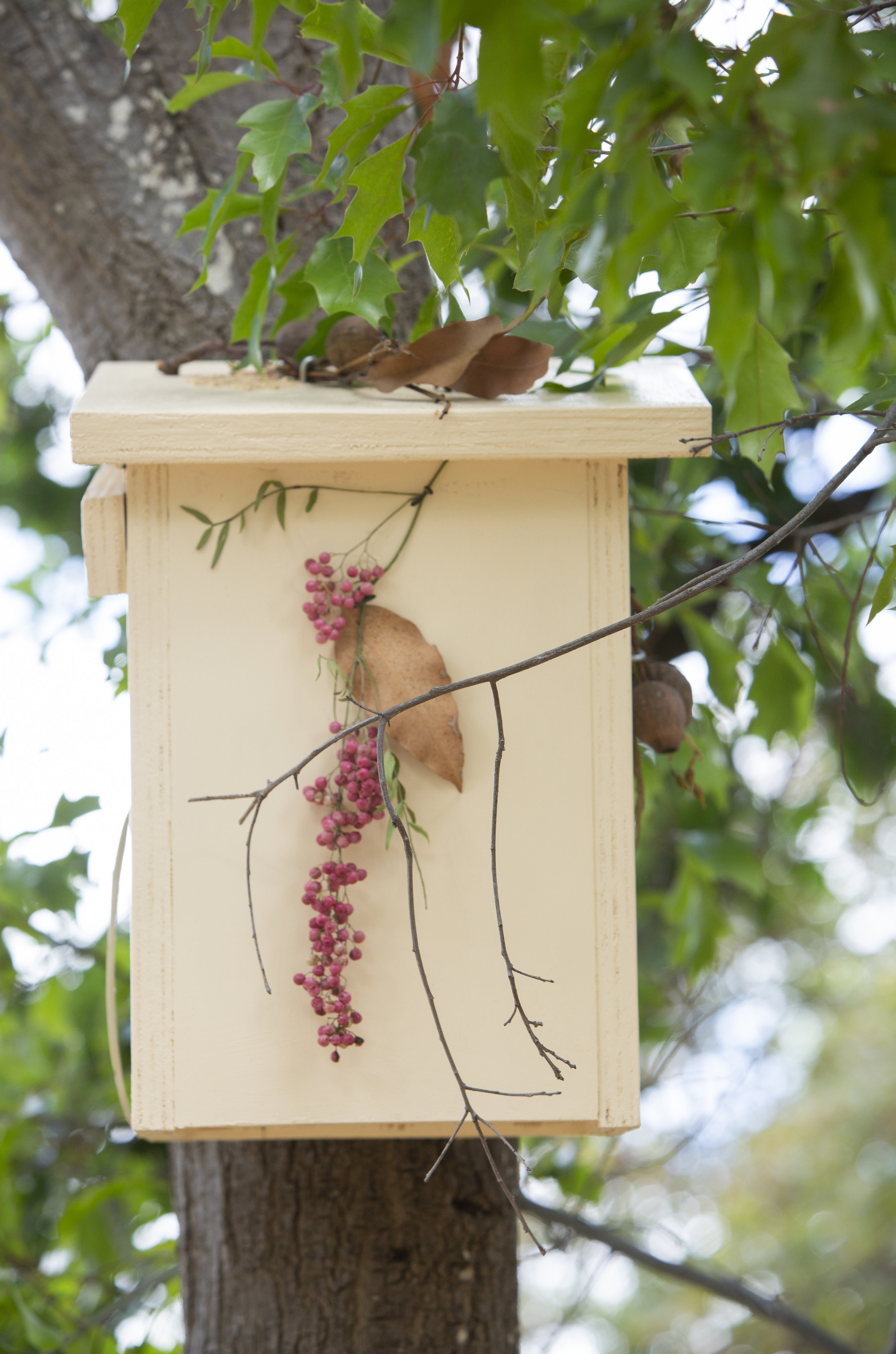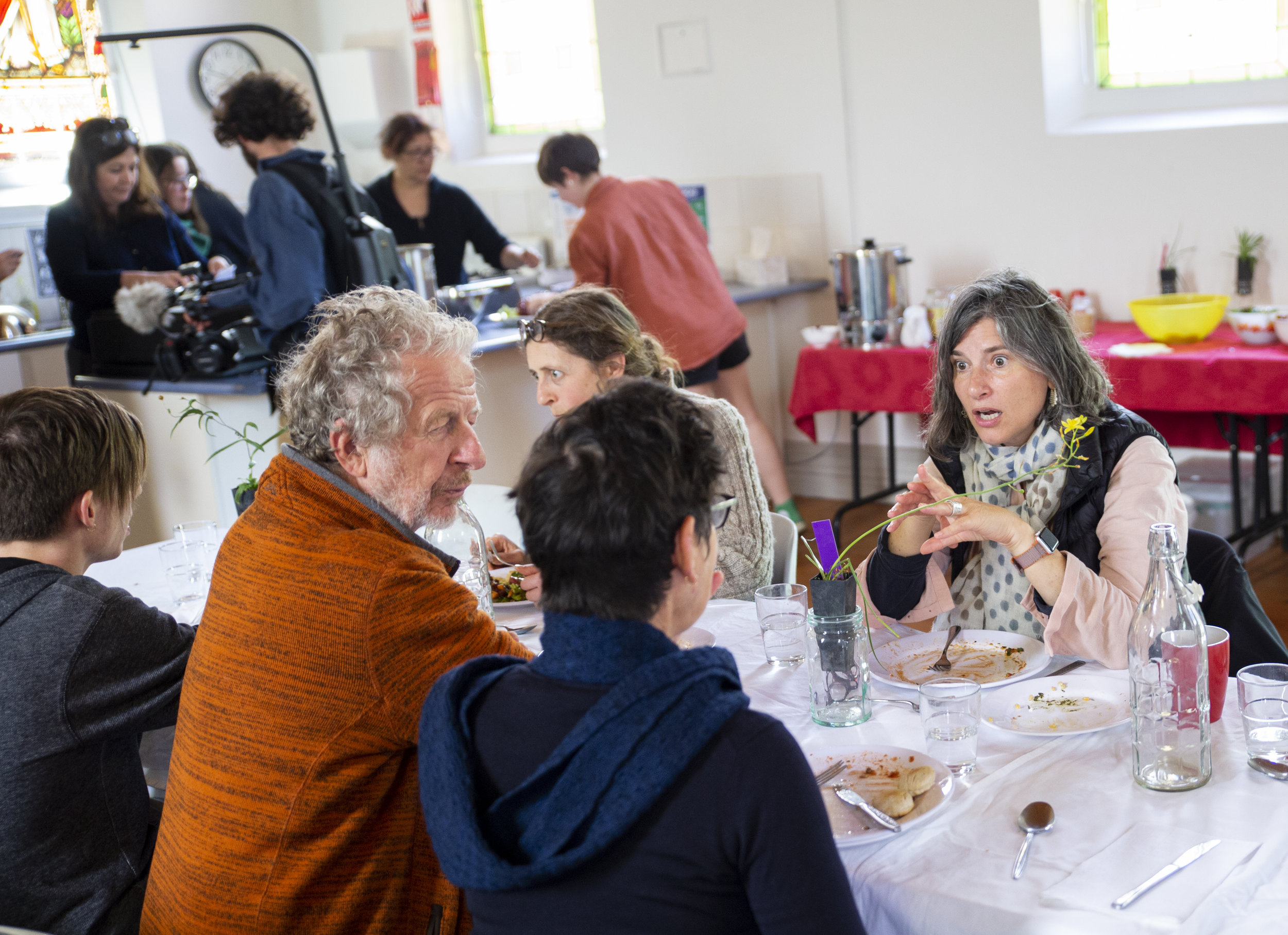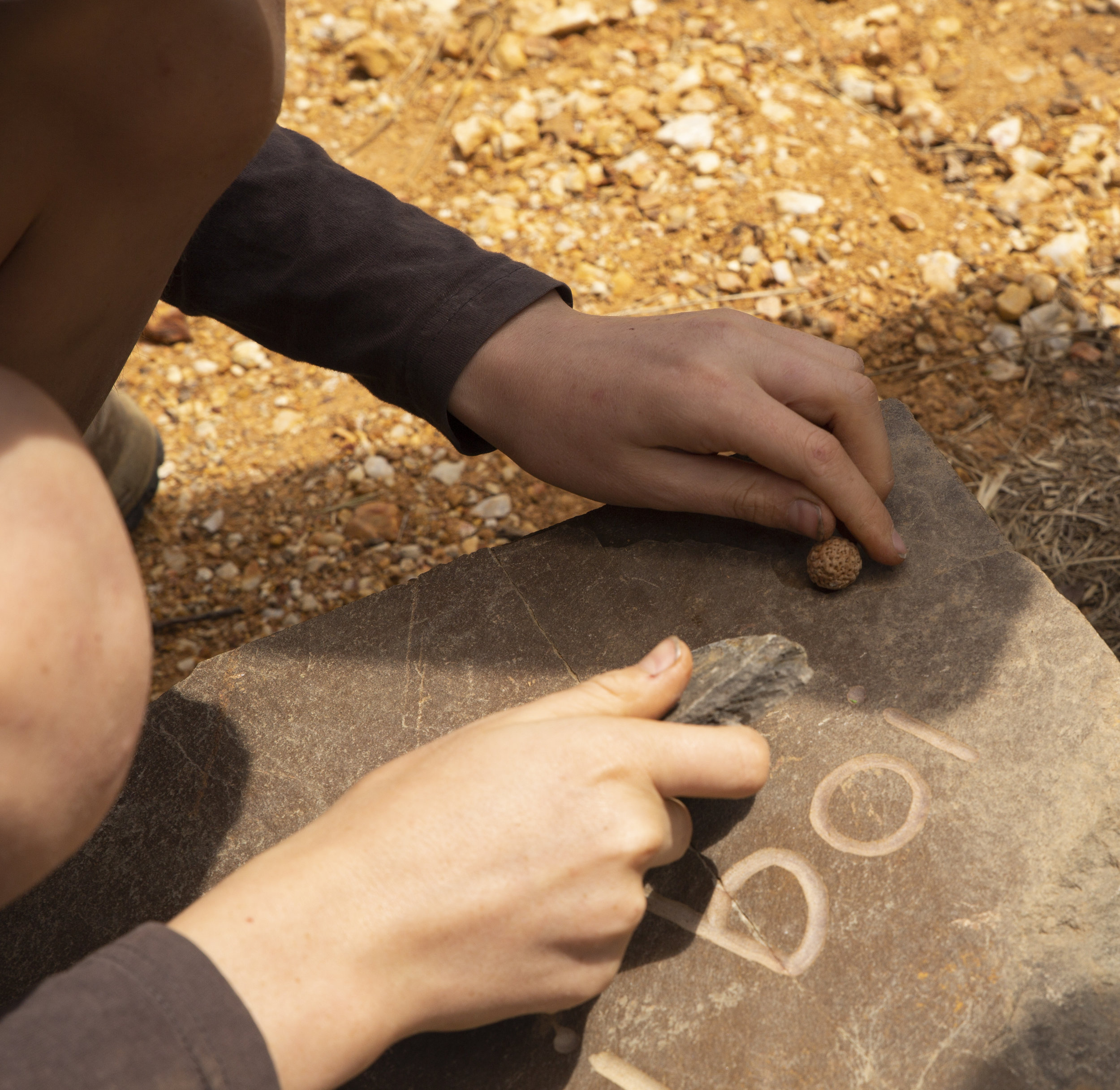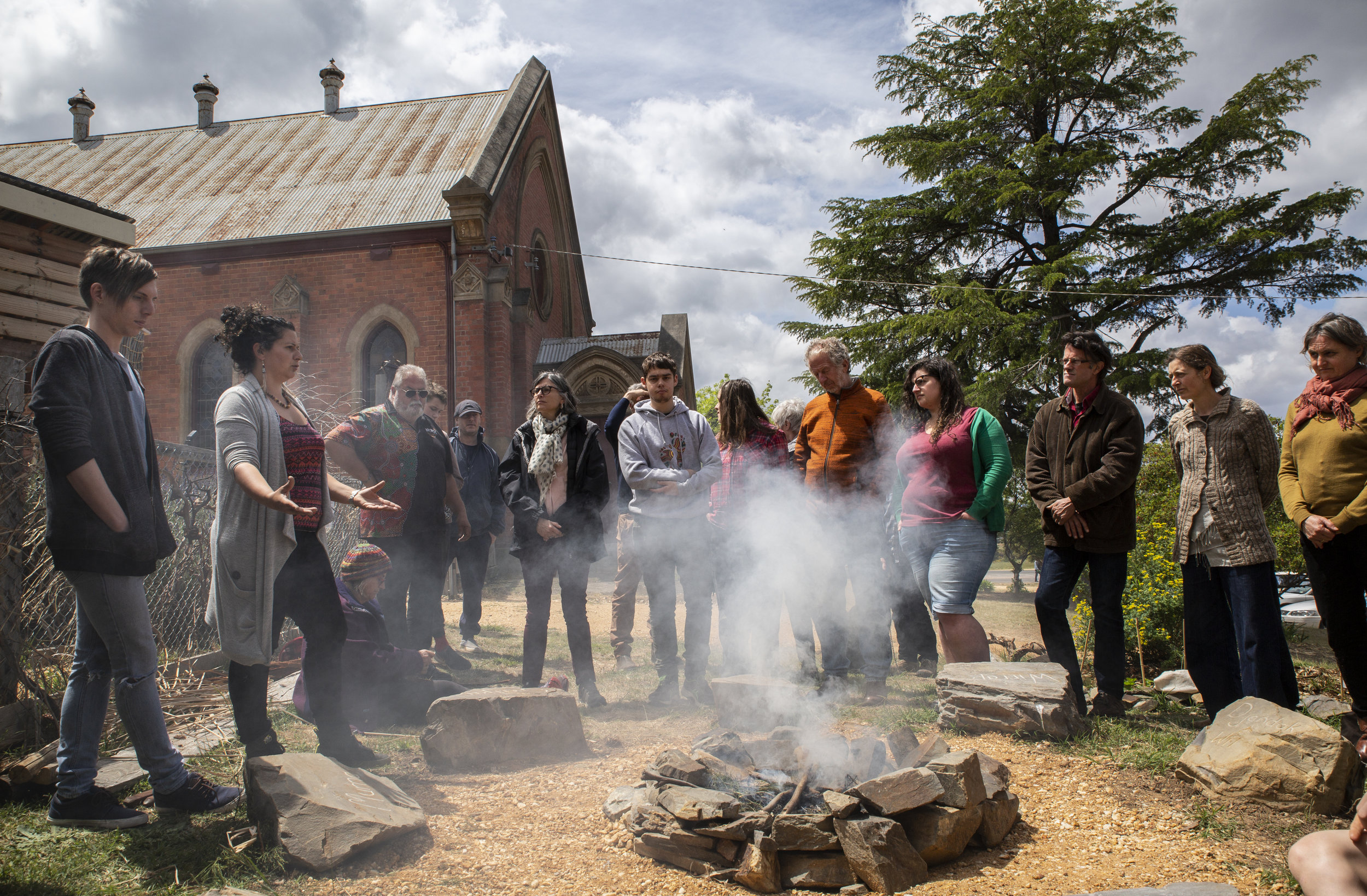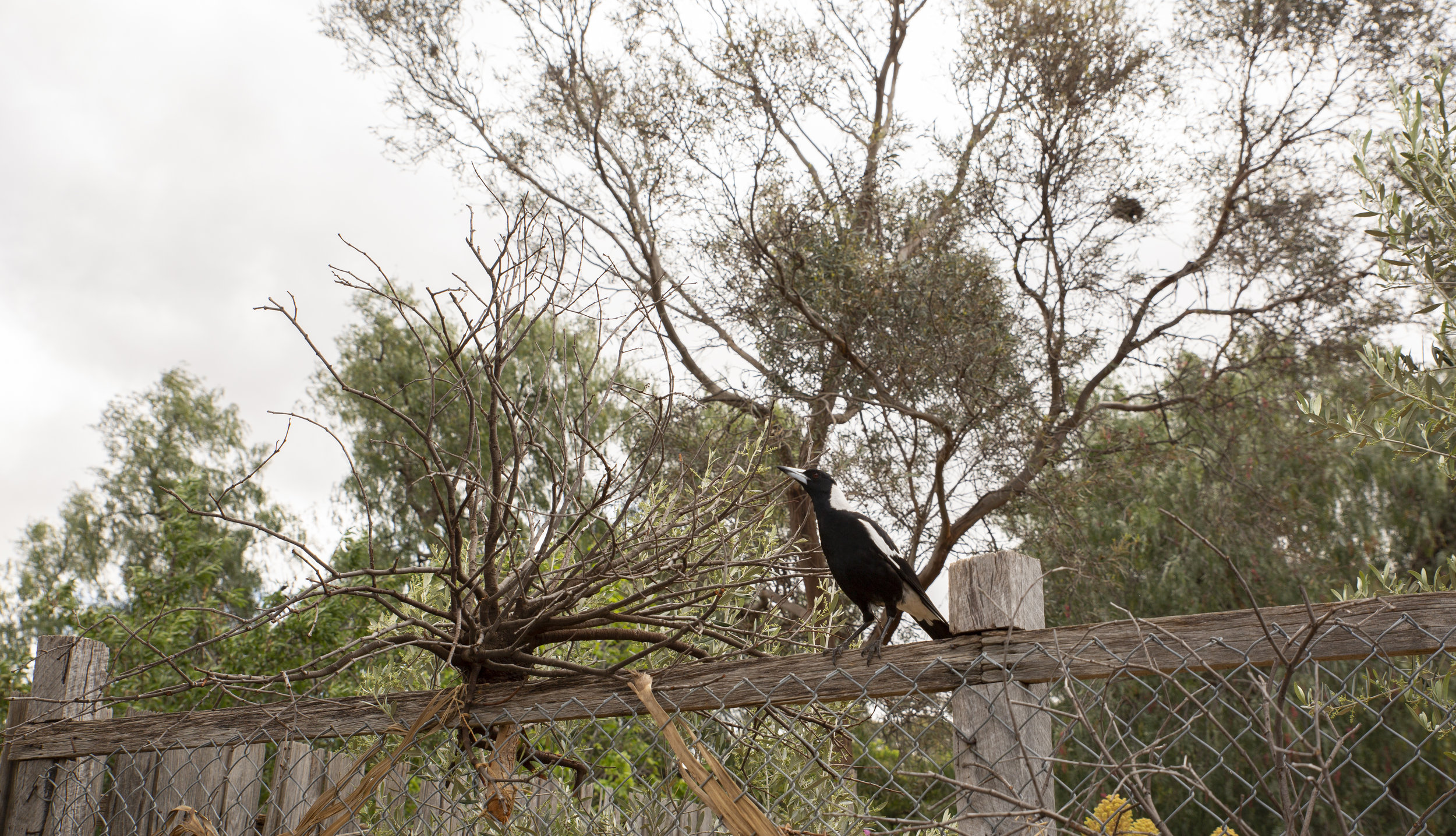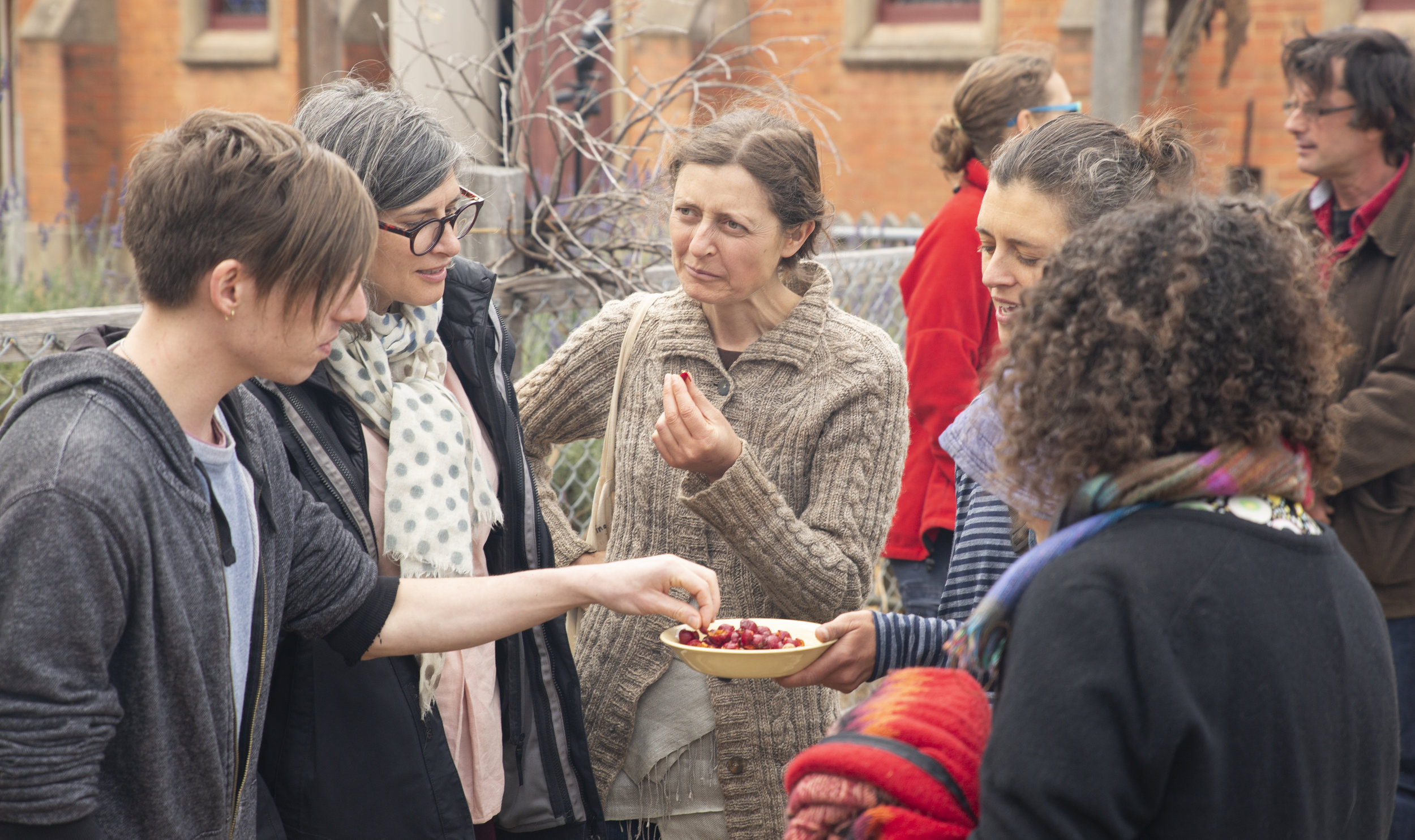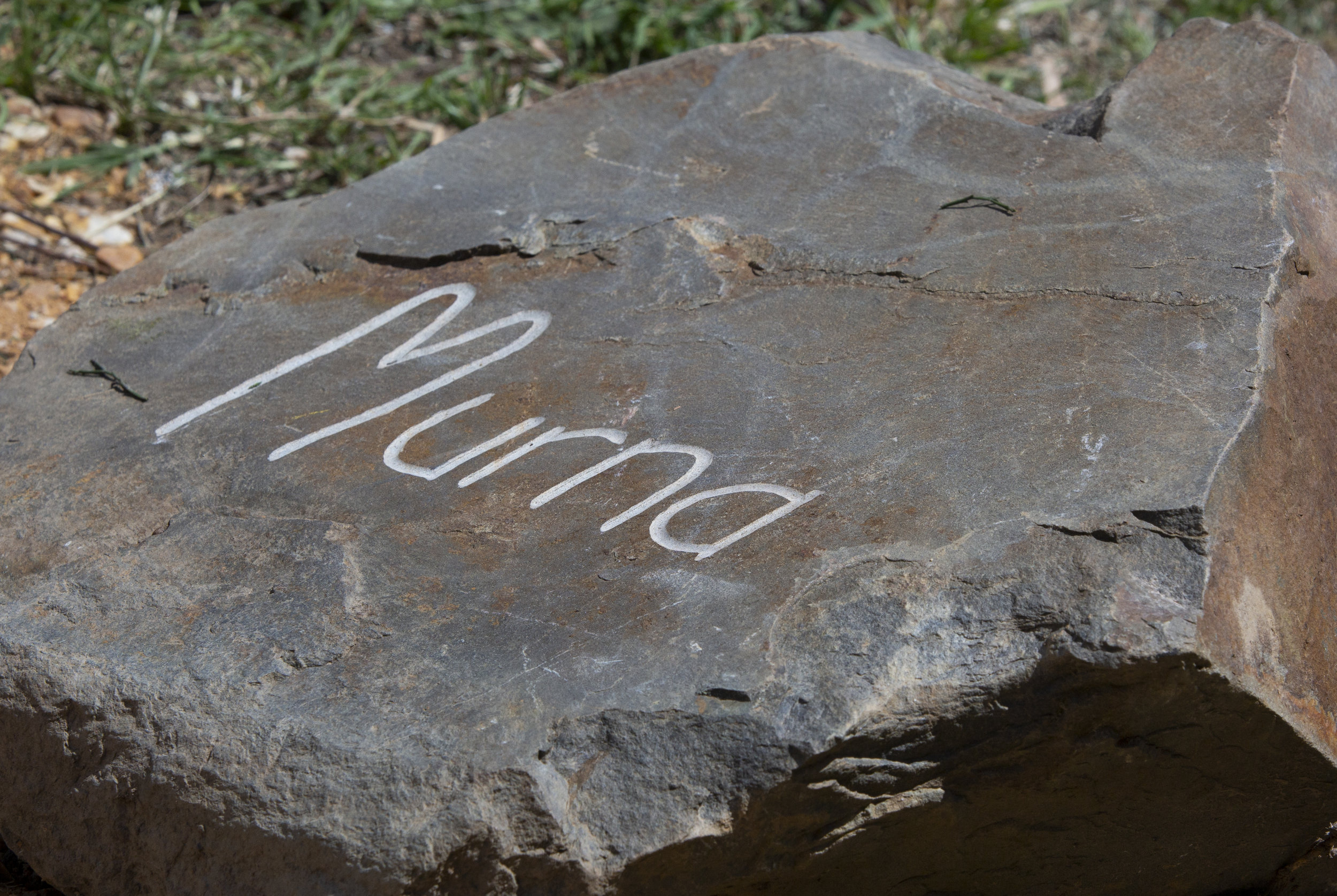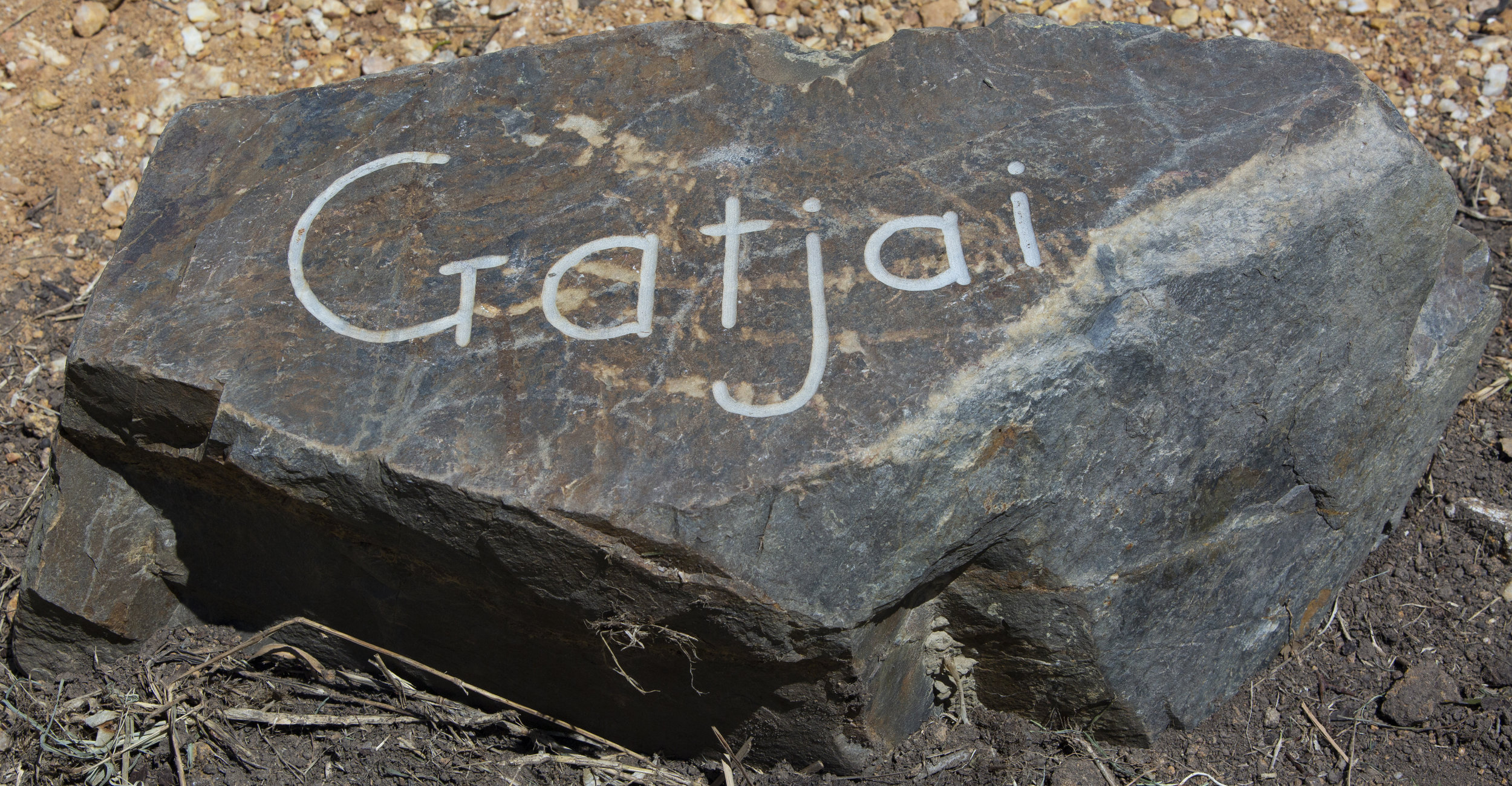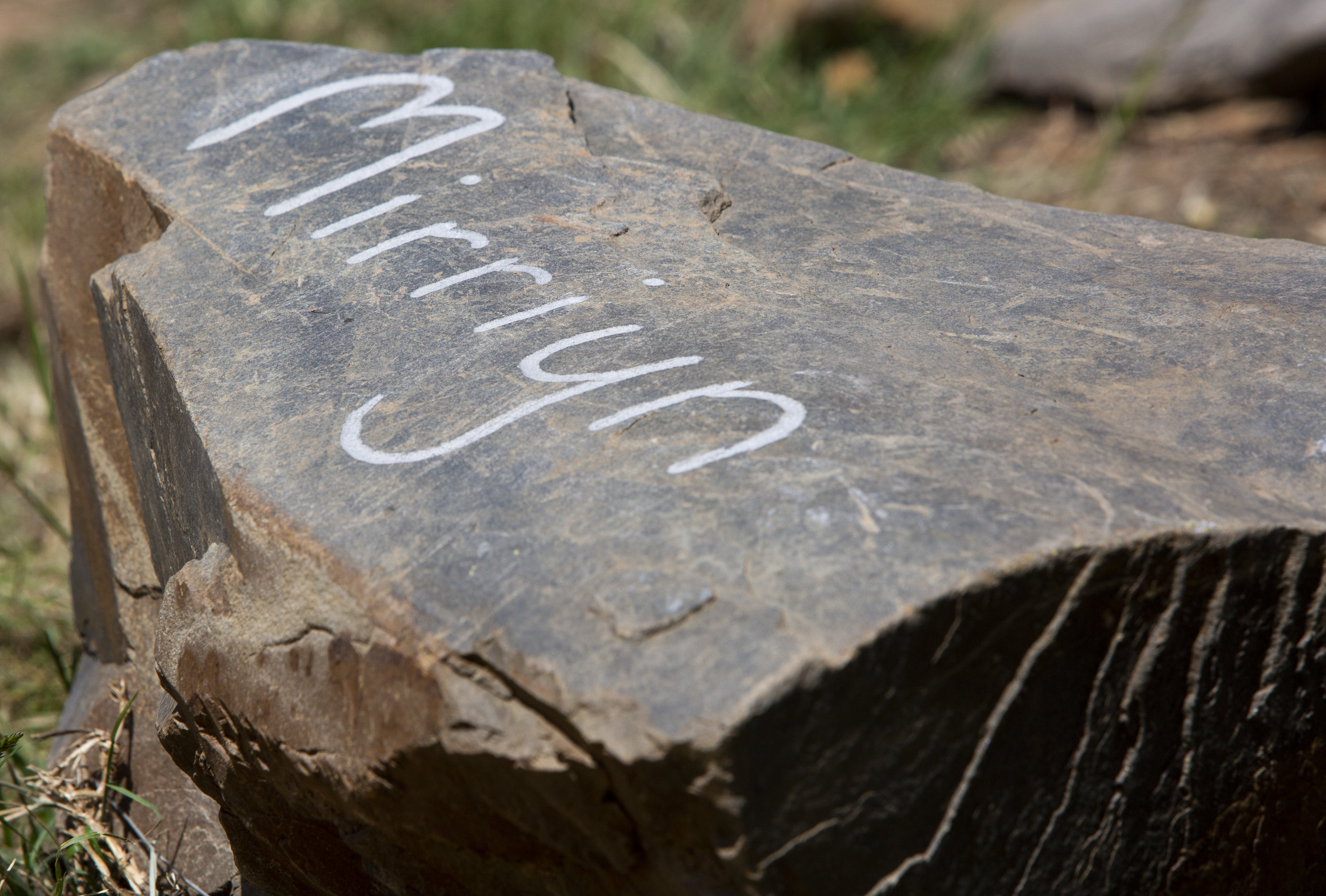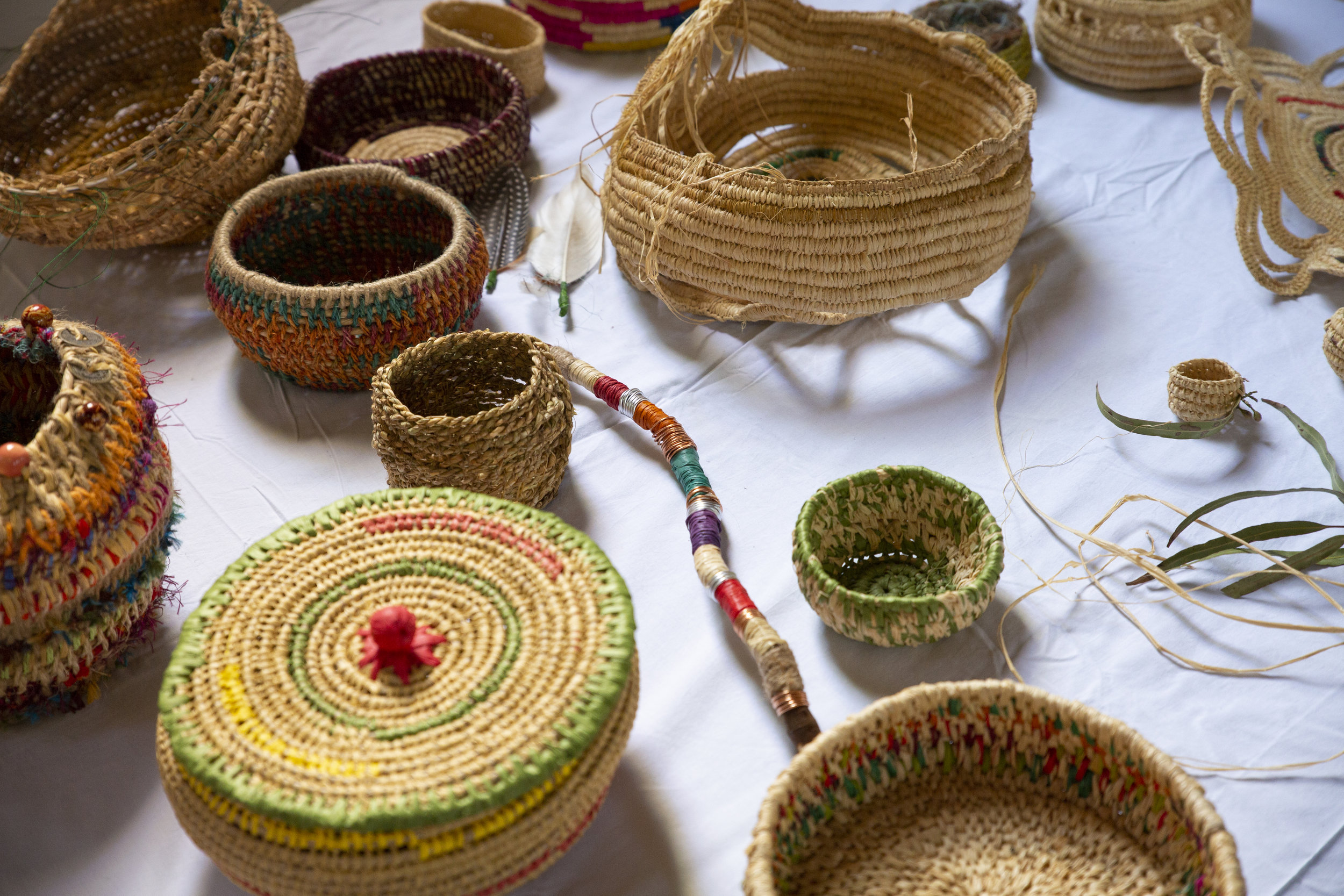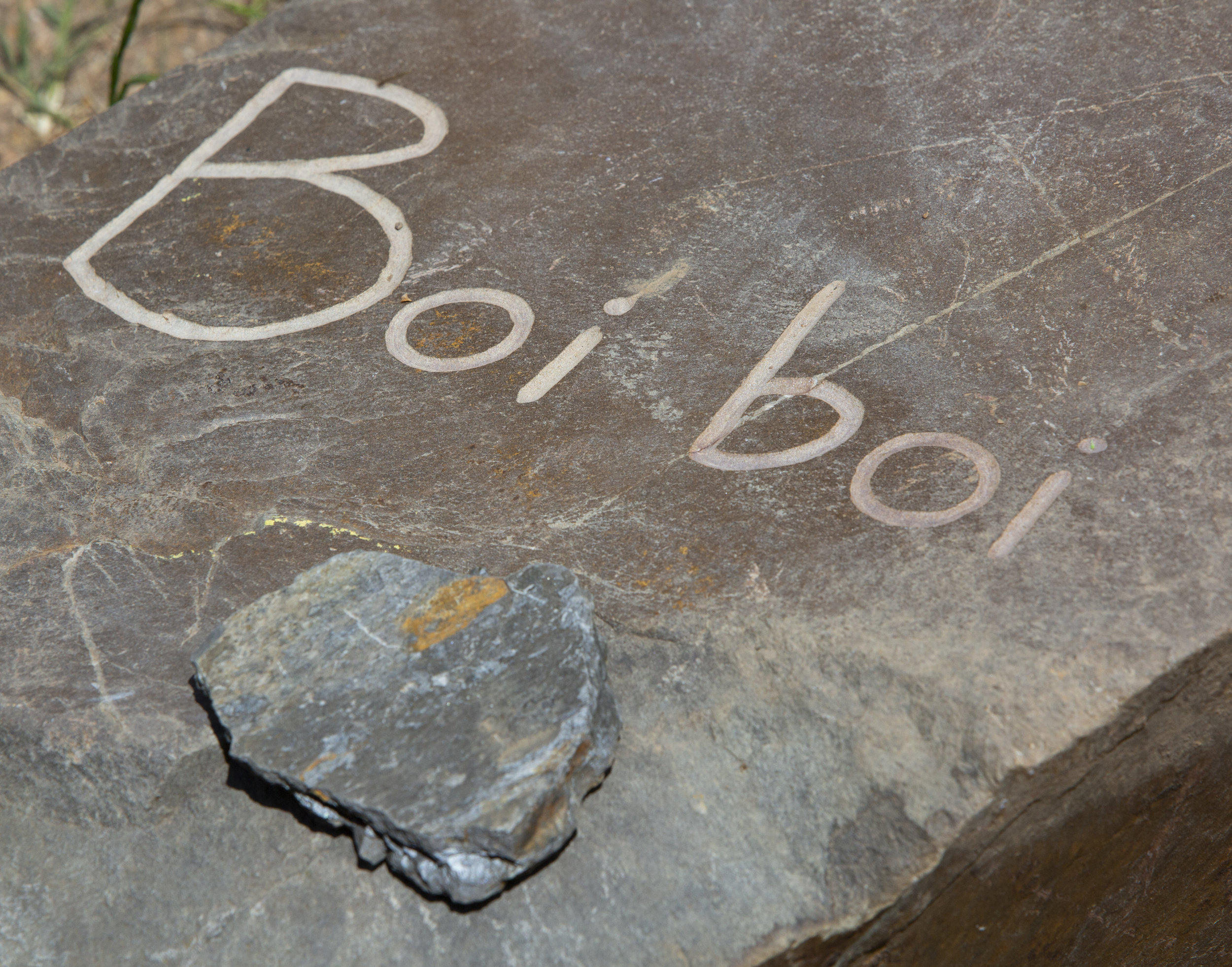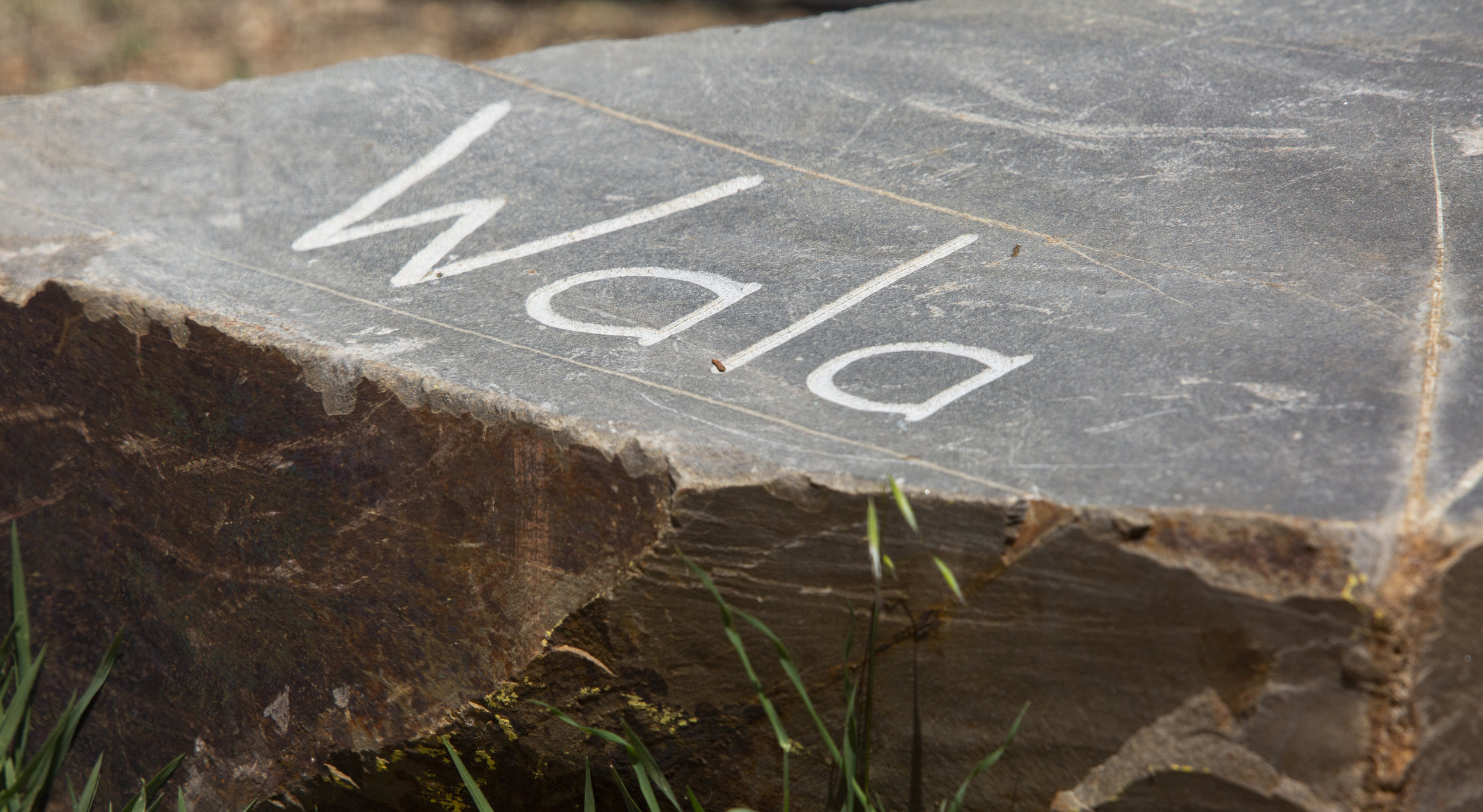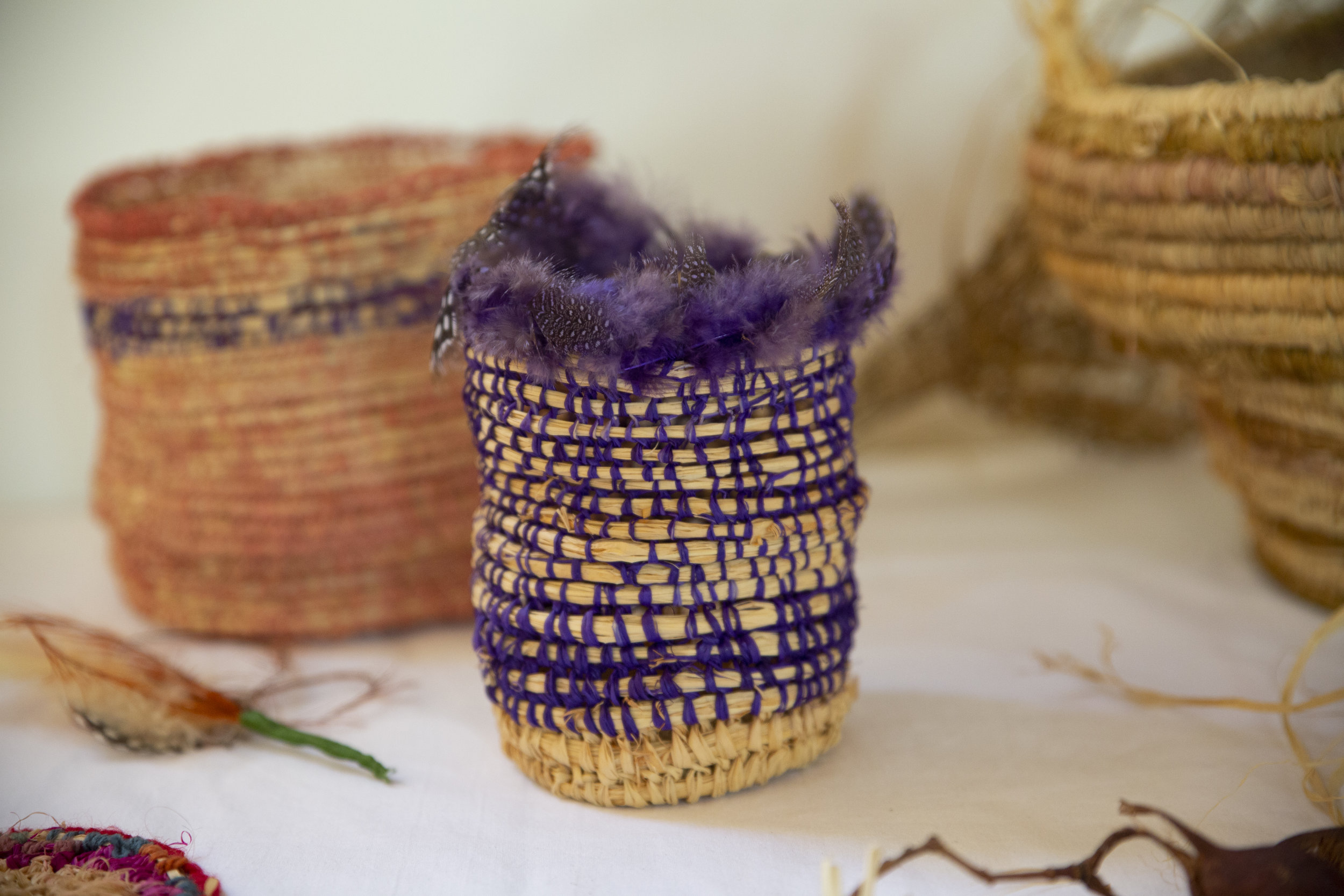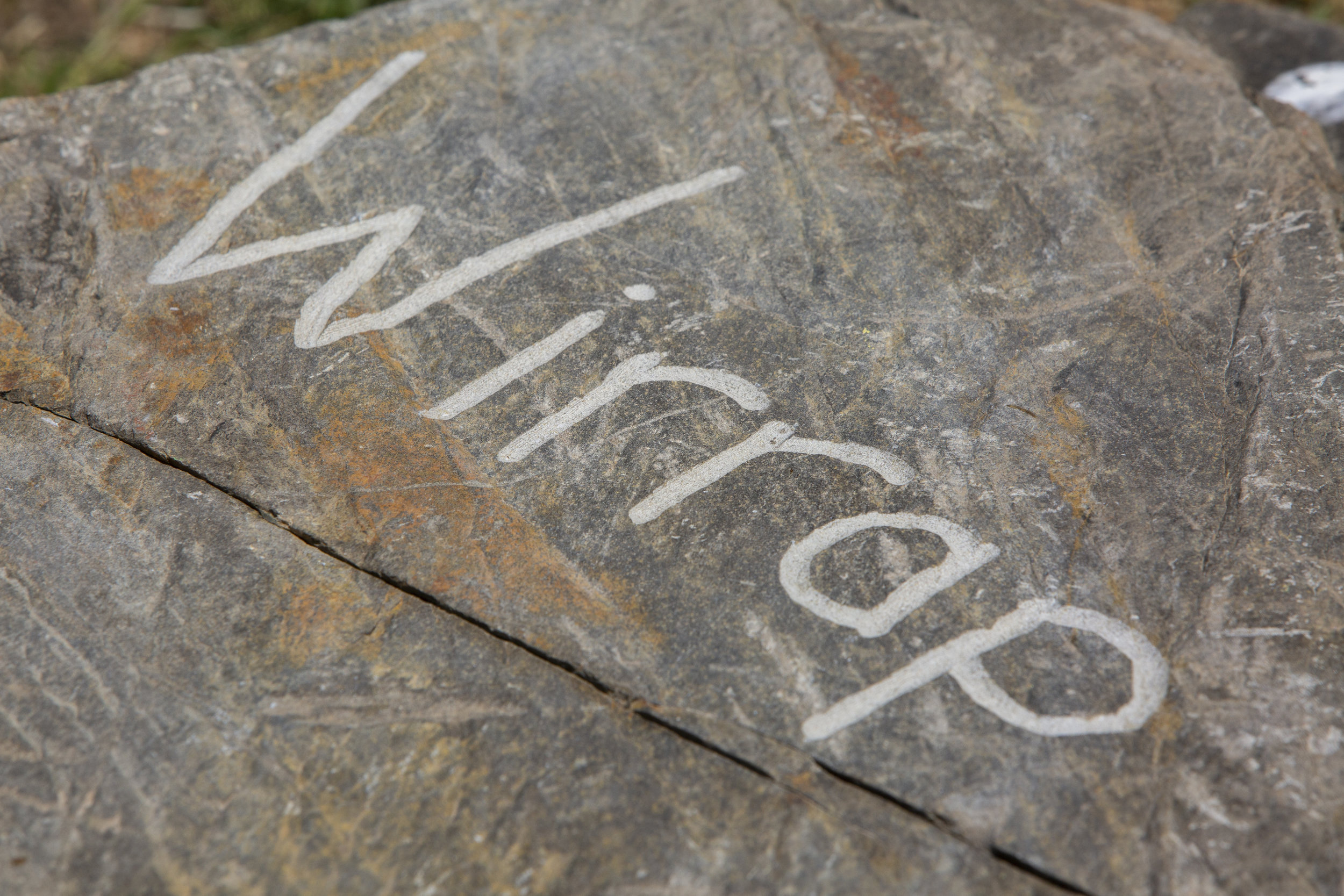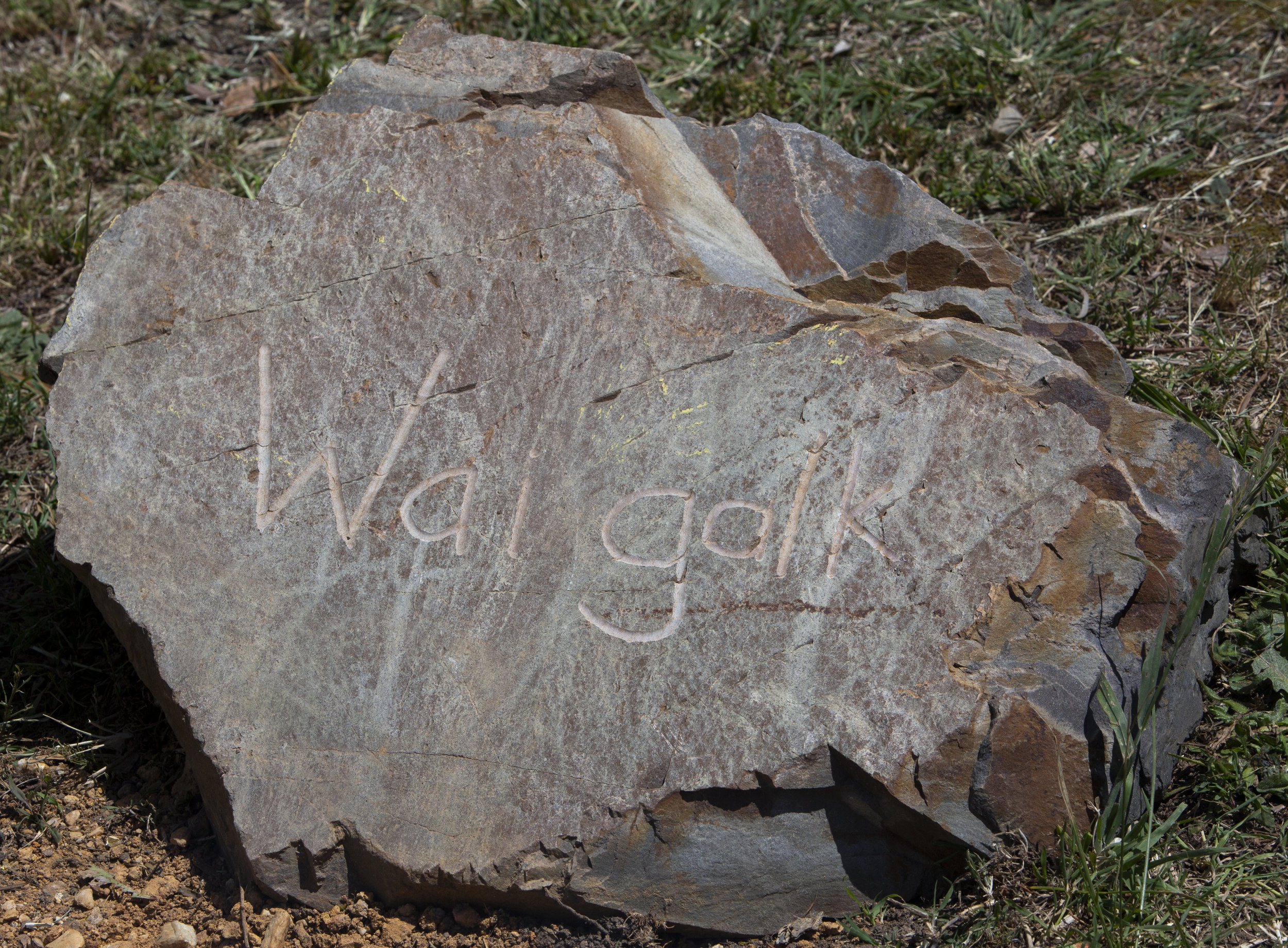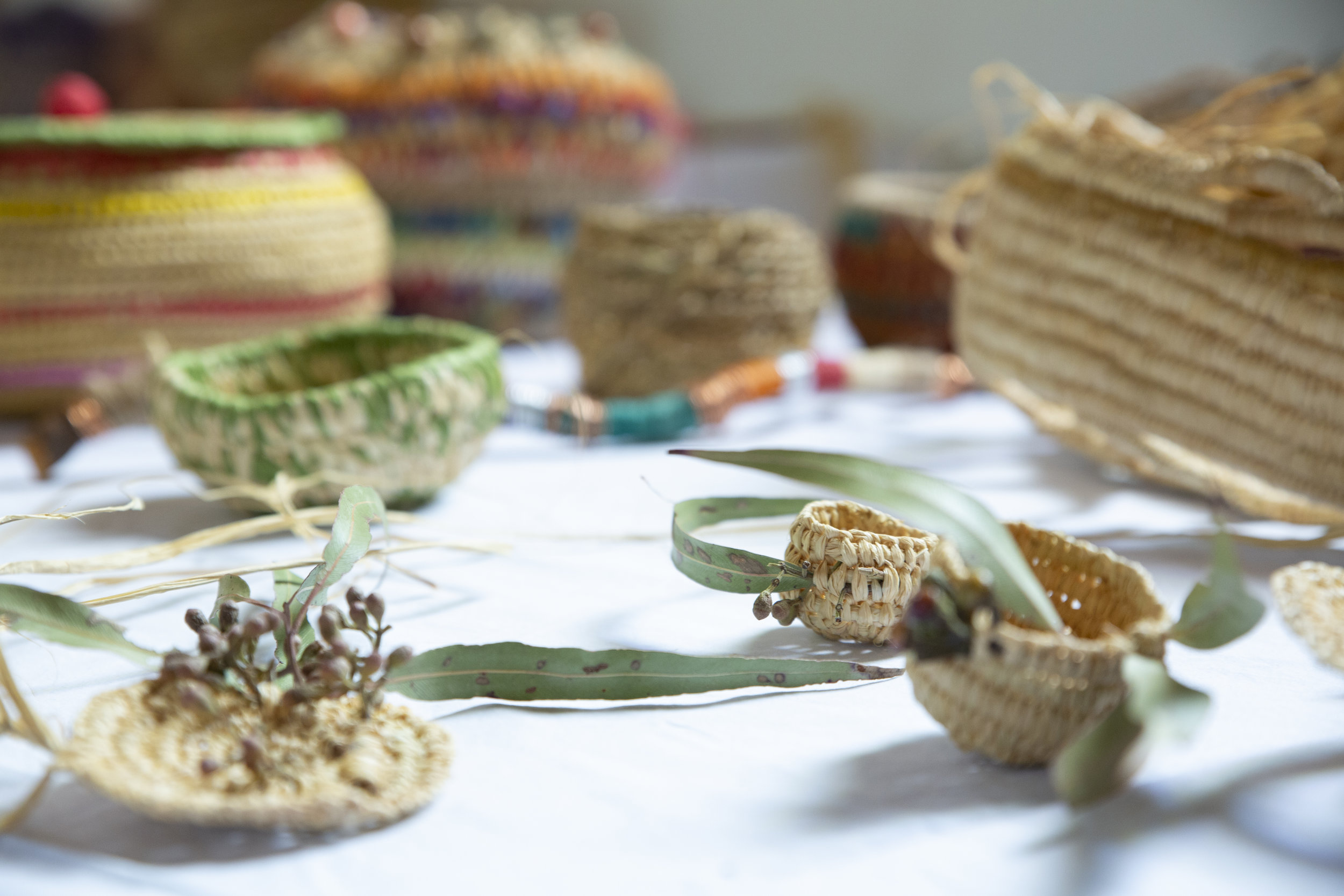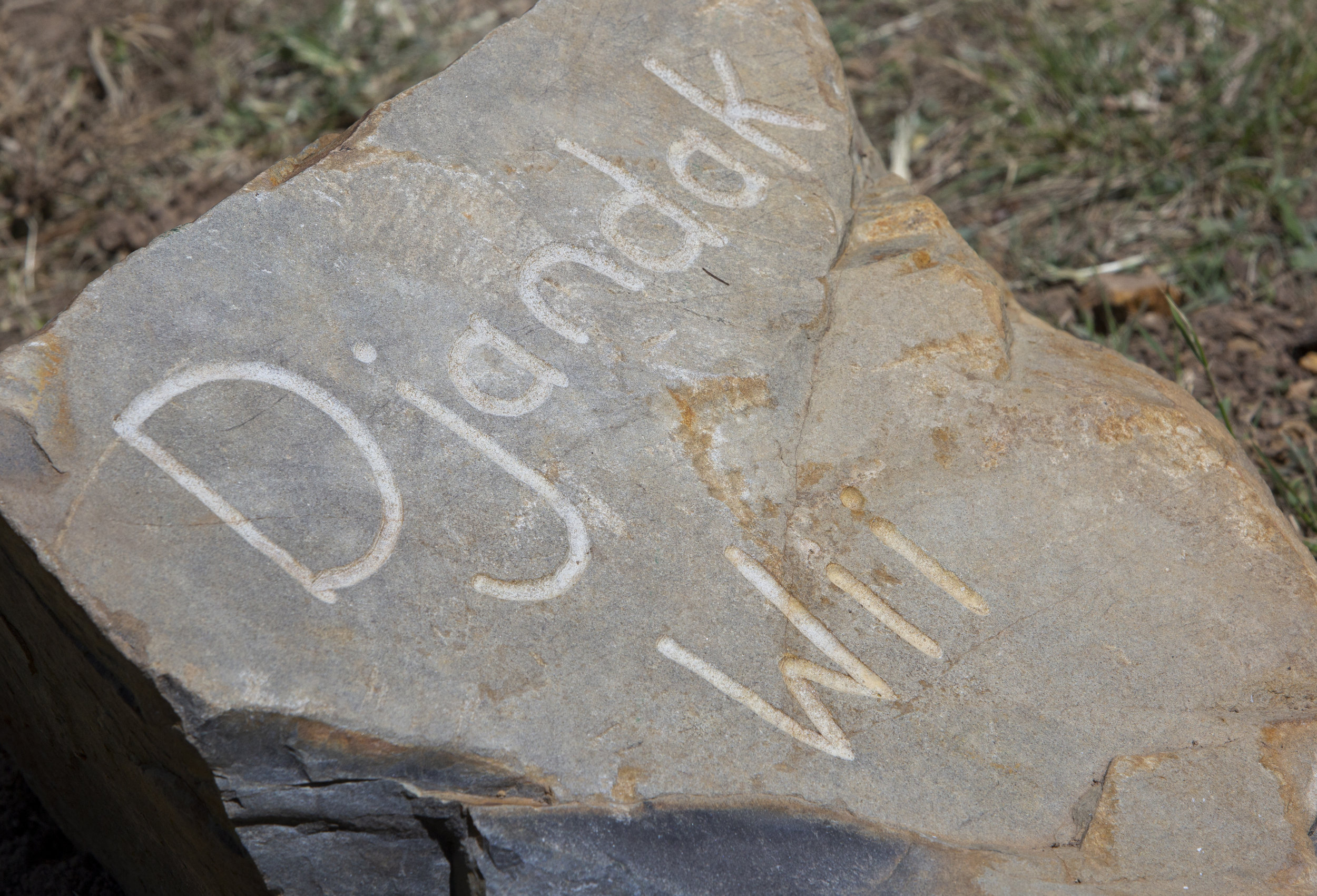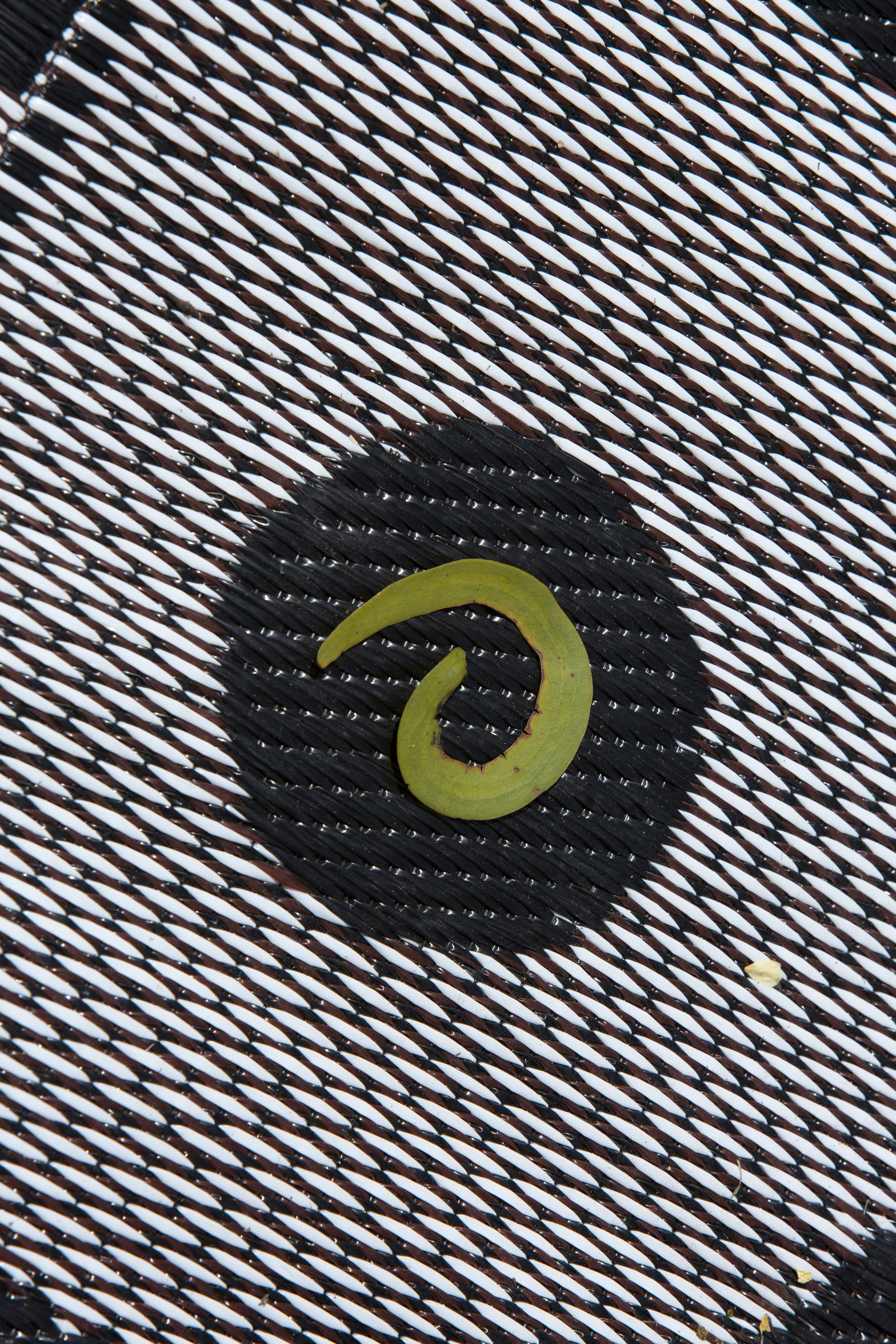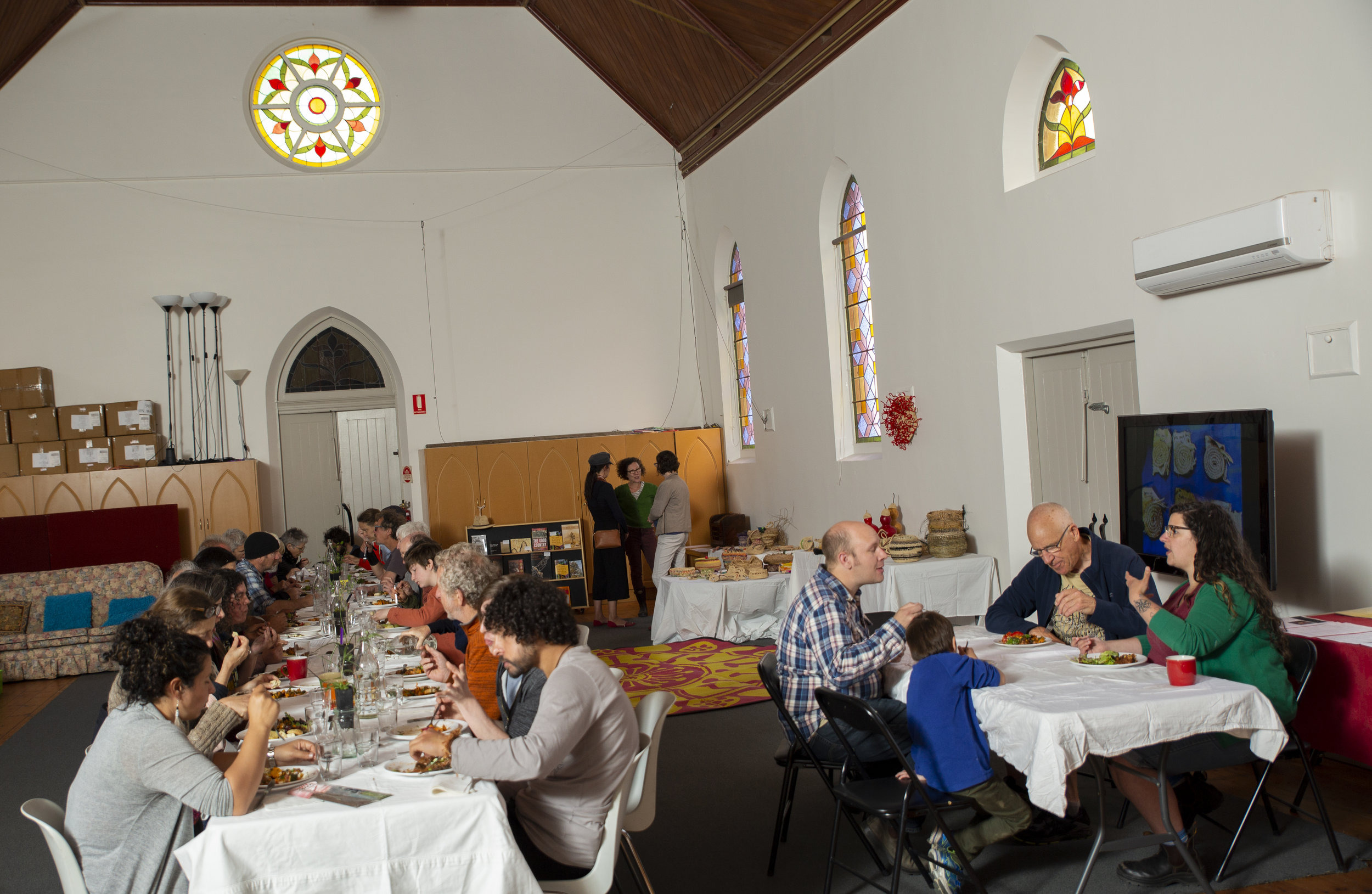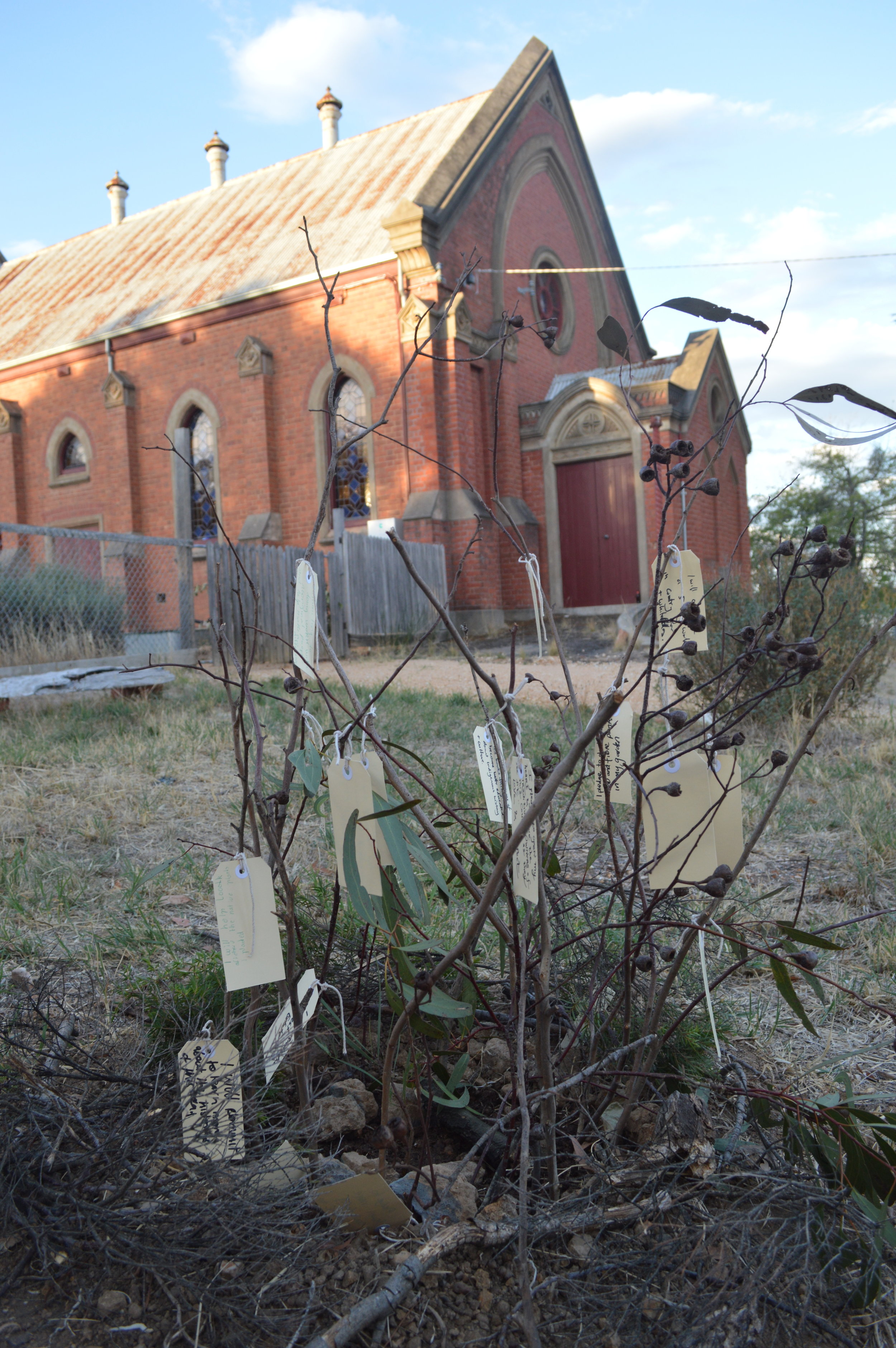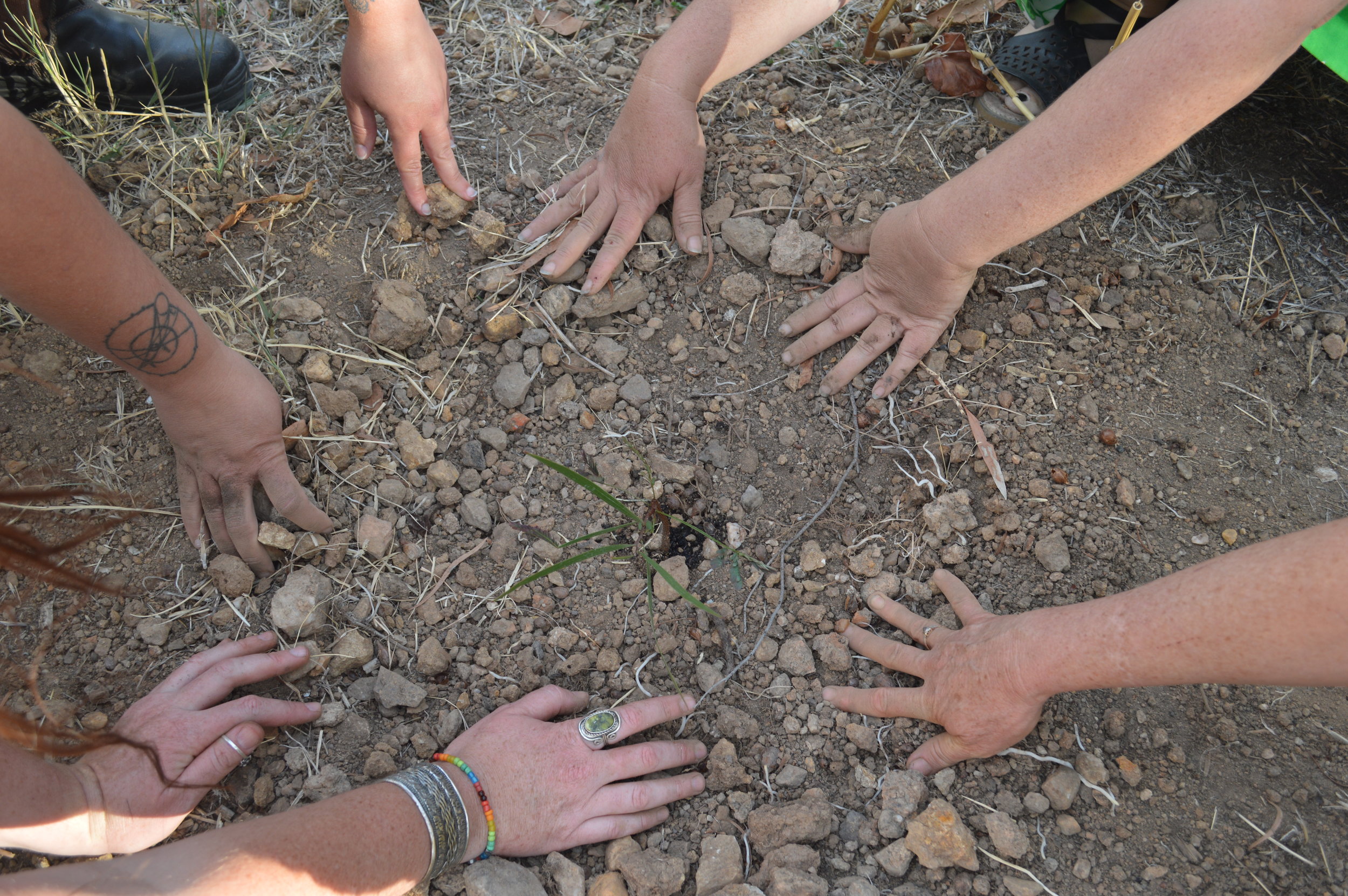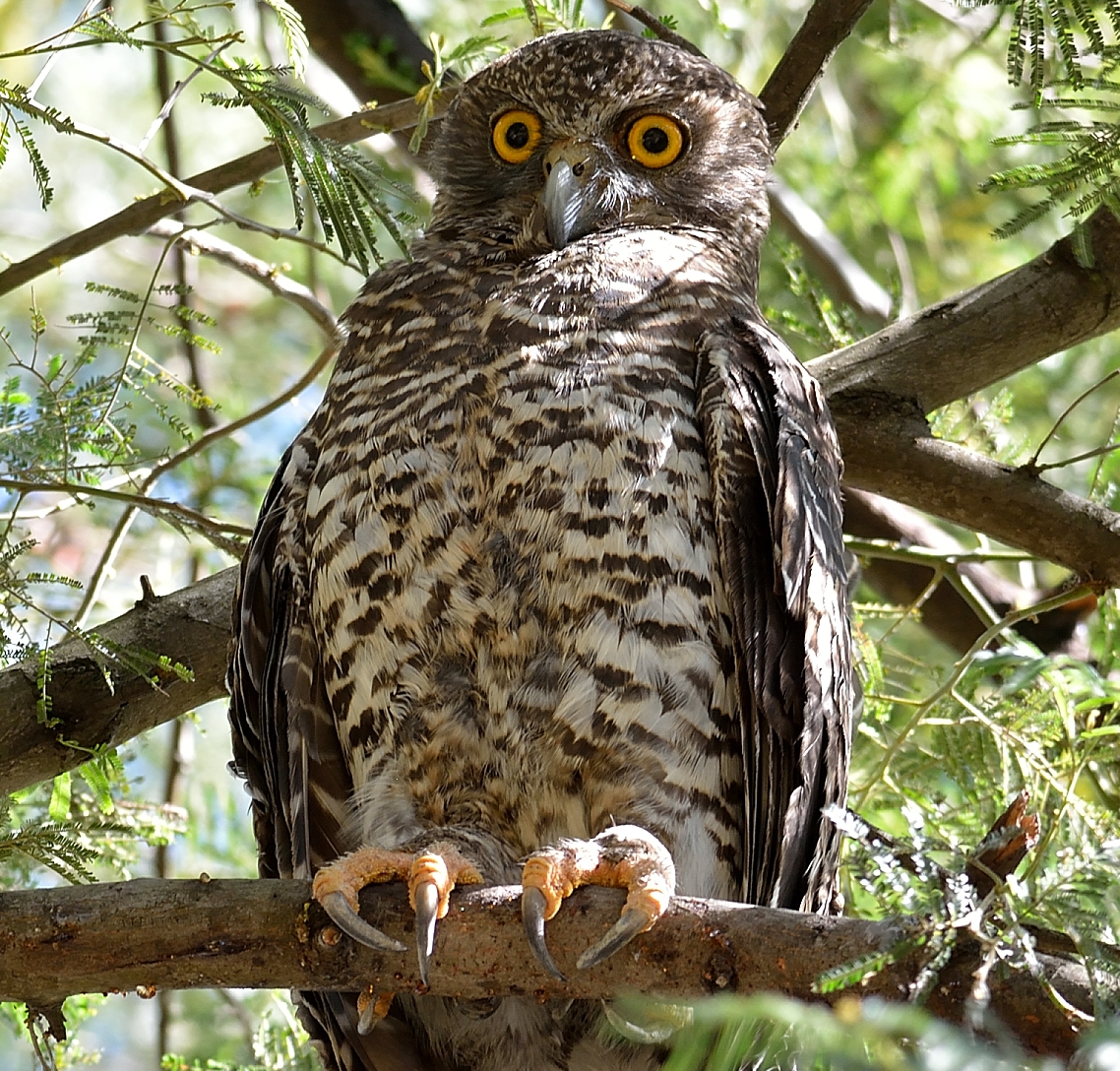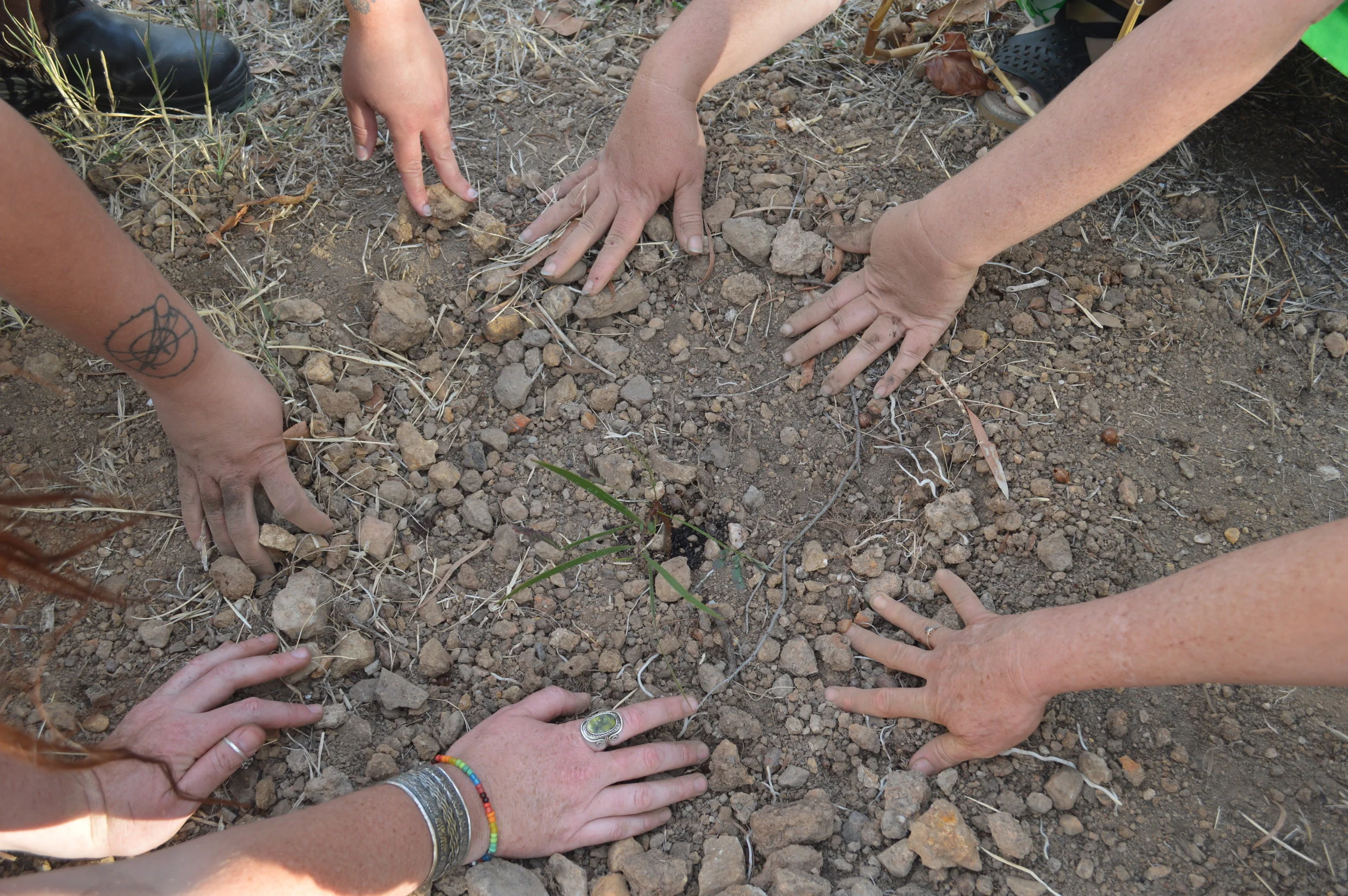Makarrata Garden Tarrangower is a community engaged sculpture project to research habitat of Powerful Owl & Duan (Brush Tailed Phascogale) and educate ourselves about the history of Dja Dja Wurrung people and celebrate their living Culture. Growing a Makarrata Garden in the hearts and minds of the Tarrangower Community. Makarrata is much more than just a synonym for truth and reconciliation or treaty. It is a complex Yolngu word describing a process of conflict resolution, peacemaking and justice. Funded by a Regional Centre for Culture Creative Victoria Local Grant.
The project is being led by Maldon artist Forest Keegel in consultation with Dja Dja Wurrung people.
Forest Keegel invited people of all genders from the Tarrangower area to Maldon Neighbourhood Centre to form a weaving group. Dja Dja Wurrung Traditional Owner, Master Weaver Aunty Marilyne Nicholls generously taught us about Traditional Victorian Coil Weaving Culture, weaving techniques and how to weave with raffia .We learnt some of the protocols around respecting Traditional Cultural practices: the importance of acknowledging our teacher and drawing from our own cultural traditions without appropriating Indigenous practices. We gained an insight into the tenacity and strength of dedication First Peoples have to pass on practices from the Oldest Living Culture, which Settlers did their best to extinguish. We met monthly for 6 months. Weaving and yarning in a circle as we grew skills and enjoyed the simple pleasure of coil weaving together and the magical intimacy and connection that only a weaving circle offers. Culminating in an exhibition at Exhibit B in Bendigo until 25 October and at the Maldon Neighbourhood Centre on October 27 .
People came along to contribute to the Makarrata Garden Tarrangower visioning on May 27th planning together for a collaborative sculpture. The project continued with Indigenous planting, conversations and sculptural nest box creation and including Maldon Focus’ Quarterly Conversation La Larr Ba Gauwa by Indigenous leader Rodney Carter CEO of Dja Dja Wurrung Clans Aboriginal Corporation on Monday 2nd July.
Makarrata Garden Tarrangower forges connections between the Tarrangower community and local Indigenous cultural heritage of the Traditional Owners, the Dja Dja Wurrung people. We want a Makaratta Garden to grow in the hearts and minds of those who live in Tarrangower (Maldon & environs) – strengthening their connection to the land and to the Traditional Custodians – the Dja Dja Wurrung.
Regional Centre for Culture 2018 is a year-long celebration of arts, culture and community in Victoria's regions. To find out more about this project, please contact Maldon Neighbourhood Centre on 5475 2093 or email info@maldonnc.org.au or check out our website or Facebook page.
Makarrata Garden Tarrangower Visioning
Sunday, May 27, 2018
3:00 - 5:00 PM
Everyone is invited to have input and share ideas for a collaborative sculpture which will respond to the MaGaTa (Makarrata Garden Tarrangower) themes- honouring Dja Dja Wurrung Culture and local threatened species- Powerful Owl & Duan (Brush-tailed Phascogale)The sculpture might include indigenous plants, nest boxes and other elements of habitat creation.
Regular sessions will be held on Thursday afternoons at the Neighbourhood centre to create the sculpture.
No experience required
All Welcome
The Experts came back
Why do the Dja Dja Wurrung Need a Country Plan
Rodney Carter Talk at Maldon 2nd July 2018
Over 200 hundred years ago experts managed this land they did so through the accepted scientific process of observation. Observations not solely by inward looking in their analysis but by direct engagement with the landscape and the appropriate utilisation of its natural resources.
As one of the oldest living cultures in the world the Dja Dja Wurrung are as first people and the first conservationists. And within the principal of true conservation our spiritual beliefs came into being, our enjoyment of life, committed us as a people through ceremony, the songs and dance the stories that ensured appropriate behaviour. This creaated structure around our Lore.
The Dja Dja Wurrung had at that time the right management in place for their landscape and lifeways. Testament to this is the analysis of the landscape by Bill Gammage, which through his analysis and interpretation of images, diaries and journals, sees the landscape as the greatest estate on earth, looking like manicured parklands. And He states that Aboriginal people managed land in a far more systematic and scientific fashion than had ever been imagined.
1 Bill Gammage, The Biggest Estate on Earth, Allen and Unwin 2012
Over the last twenty years of my life, I have had conversations with Victorian Foresters, employees of government who talk of this landscape and how older generations had taught them and told them of stories of the diminishing woodlands and fencing of open grasslands. Though they were charged with managing Timber for modern utilisation and were applying silviculture, they had heard stories of how the landscape once looked and felt. These Foresters and the Pastoralists before them had been Gardening the Environment to suit their ongoing purposes, their fault in applying their process was not how to understand how the Landscape had been managed before them.
My Ancestors had been Gardening the Environment they are creators of the open woodlands that allowed animals to freely move and graze in the dappled shade of trees with bigger canopies and understory plants to flourish in the warmth and shelter of those big timbers that proudly gazed upon the adjacent Plains of Grasses and edible fields of plants like Myrnong.
And how can a First People achieve this, they were and sometimes are still looked upon as, quaint, un-intelligent and barbaric when the new comer’s values are imposed upon us.
The Dja Dja Wurrung as the first peoples of Central Victoria are the first modern peoples to undertake ceremony in any form and this has been confirmed through archaeology over 30,000 years ago at the area of Ravenswood evidence is to be found of our lifeways and using ochres, by physical anthropology and genetics we are modern people and even geomorphology where through the last Pleistocene ending some 11,700 years ago, we still shared landscape with glacial type features and megafauna. Our stories some so old teach us of landscape creation through volcanic processes, and those stories teach us how to respectfully treat each other and the land our mother.
In terms of group social evolution, we were and are a modern people. And our stories and how we want to be today because of this imposed modern world are not for others to impose upon us, for what we believe is right. If others impose it is modern disposition, it is modern colonisation and colonialism, it is dis-empowerment of us, our land and our Ancestors.
My ancestors never gave up believing in their culture and the complex systems of land management that we in partnership are required to explore today.
Given the disruptions in our recent history, remembering our shared history is insignificant in linear terms, but massive in terms of the effects upon the experts being excluded from the management of the lands and waters, the natural resources that the state and others has been caretaking for us. The First People are not the Custodians as most like to commonly suggest we are, this term devalues my rightful place to choose my destiny, it is others that are the custodians and Caretakers, my inherent right, which I will never cede, as my Ancestors did never cede gives me clarity to who I am.
We are now at a point in history were the Traditional Owners of this state have been respected enough, acknowledged enough by the state that we can be partners. As Traditional Owners our relationship with the state from my eyes can be seen mostly negative but not all doom and gloom because as the First People we are proud of who we are and our survival.
If you can, this perspective must be viewed through my eyes, this can and should allow through caring and opportunity to be compassionate. This is the shift that all servants of government and the broader public must take as the Traditional Owner agreements like the Dja Dja Wurrung Recognition and Settlement Agreement lives beyond elections, and changes in Departmental names and should become of our day to day business as we are partners with the State.
So here we are, partners from this point forward in the future of Victoria and Dja Dja Wurrung Country. Attempting not to redress the past injustices faced by my people, where my inherent rights can be seen as a threat to the states caretaking, but make sure the steps we now take forward build a very positive future for not only my children but for your children also.
So, in true partnership we move forward, but today many of the Servants to their master’s struggle to understand this vision and so to constructively implement the Dja Dja Wurrung world view.
The public face to implement the mechanisms of the Traditional Owner Settlement Act 2010 Legislation are the Officers required to Regulate our World, they are the best-appointed people that the state has, and to deal with a legislative process regarding the protection of Dja Dja Wurrung Country.
The Dja Dja Wurrung challenge this process in so far it is my People that require resourcing to now effectively assist the implementation and ensure the success of current and future Recognition and Settlement Agreements with the state. Underpinning these agreements and very closely in line with governments premise of the Recognition and Settlement Agreement with the Dja Dja Wurrung is the success of economic independence and empowerment. This can not be achieved if the State and others do not share their resources. And sharing is OK it ensures good partnerships, and the outcomes are achieved, and the objectives are met, but it empowers the Dja Dja Wurrung and we are allowed to lead.
For us to lead we are sometimes challenged by western views of science about Traditional Owner scientific expertise and inherent knowledge, but how good is this knowledge and what is it?
If we quote: Dr Richard Gillespie upon his work on Aboriginal Times of the year we call Seasons. 2^Look in detail at the Kulin Aboriginal peoples (Dja Dja Wurrung, Woiwurrung, Taungwurrung, Boonwurrung and Woiwurrung) and their understanding of the environment through their observations of seasons and the visual triggers that informed their lifestyles for resource use and abstinence and simply he found that the European model used in Australia just doesn’t cut it, not even close and trying to explain this in terms for others to understand is difficult and highlights the difficulties modern land managers face in categorising significance of flora and fauna types
2^ Dr Richard Gillespie, Creative Producer, Melbourne Museum ‘Gallery of Life’ 1994 and their pre and post seasonal moderations. He says we just haven’t been here long enough!
What is key in Landscape management, and even Gardening the Environment is Time, and a lot of time is needed to affect a form of Landscape Management from a Dja Dja Wurrung world view.
We all share an awareness of natural processes and modern world processes upon the landscape. But this modern society that we are a part of has been playing catch up since it took control from us not too long ago and all the while we have watched others doing things their own way and seen the changes that have been made and the influences on the world around us, our science, our songs and stories tell us of how the world was and should be. Dja Dja Wurrung need before anything else Food and Fibre. Interestingly it is a modern area for Agriculture with their Policy interest in Food and Fibre for modern products.
From any scientific process data is king, and large data sets are the best, and for collection to be over as long a period of time as possible, and observational analysis is just, and for First Peoples in Australia it is generational.
My people’s aspirations based upon our old people’s land management is seen in the Dja Dja Wurrung Dhelkunya Dja Country Plan, this is our desire to put things right in caring for country, to make us and the land well again. The Dhelkunya Dja Country Plan is from 2014-2034 and is our Strategic Plan for a form of wellness.
The world that we are all now charged with managing is based upon my people’s practices, and as managers of natural resources and land scapes. It is what most Australians find interesting and connects all of us to the environment and landscape if we are interested in it. It is all peoples connections that drives the diverse interests in threatened and endangered species and why Australia commits Millions of dollars each year to species management, to protect the environment and its eco-systems. The Plan for Protecting Victoria’s Environment ‘Biodiversity 2037’ has attempted to communicate a new approach to managing eco-systems, and though it has very strong support, there are some that challenge these new approaches and they would want to continue the way things have always been managed.
But we must adapt and try new things? But why and only for just one reason modern humans have begun, the Holocene extinction^3, otherwise referred to as the Sixth extinction or Anthropocene extinction, is the ongoing extinction event of species during the present Holocene epoch, mainly because of human activity.
^3 Holocene Extinctions. Samuel T. Turvey, editor.
Oxford, UK: Oxford University Press, 2009. 352 pp
Although extinction is a natural phenomenon, it occurs at a natural “background” rate of about one to five species per year. Scientists estimate we're now losing species at 1,000 to 10,000 times the background rate, with literally dozens going extinct every day.
What are humans trying to achieve today? When they look to the past in its entirety as a frozen moment in time and say “yes that is how it must be”.
A principal view of the world for Dja Dja Wurrung is of Gardening the environment and historically this has been founded upon our belief systems. The state and others are increasingly understanding our Vision, and as we can see today our legislative and regulatory processes still base much of its views upon the frozen moment and what things looked like in the past, but things are slowly improving.
We look at our landscape in terms of people who are not part of landscape but as humans we impact upon the landscape and we try to manage it in that context. There is a real need now for this context to change and put Dja Dja Wurrung people back into the landscape. We want Gurri, Barramul, Murnong food and fibre, we want Kapa Gatjin healthy water and the Wanyarram Dhelk systems of water to work for Djandaks Murrup natures benefit, we want Dhelkunya Dja clean country and sweep it gently with Djandak Wii ‘Dja Dja Wurrung Fire’.
Much of what we need to progress in this type of thinking will be based upon the people within government that can comprehend the Dja Dja Wurrung way of thinking about the environment.
The Dja Dja Wurrung from 200 years ago has come forward in our thinking to meet the needs of the modern worlds management after an imposed holiday not of our choosing.
We still have much of what we have learnt we are still the experts but during that holiday somebody changed our backyard and created laws to ‘Protect’ it from themselves, but what is it they are really protecting, they are protecting themselves from the lifeways that my ancestors followed, it is the regulation of the Landscape my Ancestors created.
Positively the state now recognises our need to be involved in the management of our lands and waters and our future generations will inherent the process and what achievements we can make.
The state wants us to move forward so Dja Dja Wurrung can again decide how this gardening of the environment will take place. This will require innovative and creative thinking by all involved and challenge the very flawed thinking of managing the landscape similar to a zoo or a botanical garden where the world is viewed as humans looking upon, and not being a part of the landscape.
The Dja Dja Wurrung are part of the Landscape and it owns us, and we will work for it.
END:
Dhelkunya Dja Country Plan 2014-2034 Themes
Djaara Objectives
To achieve our goal, we aim to:
• Be recognised as a sovereign Aboriginal nation and the Traditional Owners of Dja Dja Wurrung Country
• Reduce the major risk factors to our People and ensure there is access to appropriate health services and housing
• Have more Dja Dja Wurrung people working on Country and in stable employment
• Ensure our full range of rights and interests are legally recognised and reflected in the policies of government.
Cultural Practices and Customs Objectives
To achieve our goal, we aim to:
• Actively practice our ceremonies and teach our ways to our young ones
• Reclaim, revive and rejuvenate our language
• Consolidate and protect our traditional knowledge, using it to guide cultural practices and the way our Country is managed
• Advance reconciliation with the broader community by sharing our stories, values and customs.
Cultural Heritage Objectives
To achieve our goal, we aim to:
• Strengthen our understanding of what significant sites and artefacts exist on Dja Dja Wurrung Country
• Secure the right and means to effectively protectand manage cultural landscapes and sites
• Ensure Dja Dja Wurrung ancestral remains, cultural objects and collections are returned to Country, and protected
• Make use of our cultural heritage to promote healing and reconciliation, teach Djaara people about their Country and laws, and raise cultural awareness among the broader community.
Bush Tucker and Medicine Objectives
To achieve our goal, we aim to:
• Understand what plants and animals now exist on Country, and what condition they are in, so we can better define appropriate management regimes including an appropriate ‘cultural take’
• Re-build the capacity of our community to care for Dja Dja Wurrung Country and the knowledge of our community of our Country and our species and ecosystems
• Actively manage our traditional lands and waters to protect the plants and animals that are important to us; and promote the right species in the right places, so they can provide for us in a sustainable way
• Get out on Country to hunt and gather as per our Authorisations Orders
• Work with relevant authorities to ensure our active participation in wildlife management and harvesting
• Ensure traditional ecological based burning regimes and practices are reintroduced across Country and work with land managers to carry out our role in fire management to support restoration of biodiversity, including species and ecosystems of cultural and customary importance
• Lead the way in active restoration interventions to restore and protect biodiversity, with a particular focus on our Aboriginal Title lands
• Have our cultural priorities incorporated into fire and biodiversity management decision-making
• Be accepted as legitimate users of natural resources.
Rivers and Waterways Objectives
To achieve our goal, we aim to:
• Ensure all of our waterways are healthy, with the right water in the right place at the right time to meet the needs of the environment, Djaara People and the broader community
• Have a recognised and legitimate role in water governance, with genuine consultation in policy development to take part in decision-making about our waterways
• Secure adequate and equitable water rights that meet our social, cultural, spiritual, economic and environmental needs
• Share our creation stories to teach people how water works in the landscape.
Upside Down Country Objectives
To achieve our goal, we aim to:
• Understand the extent of damage to Dja Dja Wurrung Country caused by mining
• Be involved in the design and implementation of remediation works and restoration initiatives in upside-down Country
• Build our capacity to remediate toxic land
• Have areas of land handed back that are sick and not being healed and be effectively resourced to conduct the required remediation.
Self Determination Objectives
To achieve our goal, we aim to:
• Be a clearly identified group of people with well-defined goals and objectives, authority and leadership structures
• Have a strong, well-governed corporation that effectively represents the interest of Dja Dja Wurrung People
• Effectively implement the Dja Dja Wurrung Recognition and Settlement Agreement
• Be meaningfully involved as a partner in managing Dja Dja Wurrung Country, and take the lead in managing Country where Dja Dja Wurrung People hold freehold and Aboriginal title
• Have an active and engaged community that participates in all aspects of society.
DJA DJA WURRUNG SELF-DETERMINATION STATEMENT FOR RSA REVIEW
Our right to self-determination is recognised by international law, and Dja Dja Wurrung people (Djaara) want that right to be respected and enabled here on our homeland. We have a right to participate fully in social, political and economic life, to protect and develop our unique identity, and to make decisions about our country.
Self-determination will allow us to work our way out of contemporary colonialism’s racism, injustice and continuing dispossession and its negative effects on our daily lives.
We believe we have the right - and should have the opportunity - to manage our djandak (our land) and to earn income from it: as a group and as individuals. We believe that the wealth created from the resources of our country should applied to Djaara to end our economic and social disadvantage.
We want the right to work cooperatively with governments which respect our right to make our own decisions about what is good for us. Self-determination means others acknowledge our right to identify and achieve measures which overcome decades of disadvantage, lack of opportunity, discrimination and exclusion from decision-making. Self-determination means we can deal with government as properly-resourced equal partners. We need a fair share of public funds and community wealth which was built from the use of our country’s resources to be able to do that.
Self-determination means we, as a distinct people with our own language and identity, will engage with government and pursue our economic, social and cultural development.
Self-determination means we have the right to mend our upside-down country and make decisions about how our country is to be managed. We want to be back on our land and visible on our land: we are of the land, we have responsibilities to the land, and we need to speak and be heard as the first people of the land.
Self-determination for Dja Dja Wurrung people means the right for us to live safely, and happily, and in comfort, and with purpose, according to our own values and beliefs. Self-determination means the right for us to be respected by others, to be proud Djaara, and to make our own way in life.
Self-determination means we are genuinely regarded as being as good as anyone else, but with a unique identity, history and knowledge. We want to have, and we want our children to have, the security of homeownership, healthy lifestyles and the opportunities of full education.
Self-determination means the Dja Dja Wurrung people are known and respected as the owners and managers and carers of our lands since humans first walked it.
Traditional Owner Economy Objectives
To achieve our goal, we aim to:
• Grow our asset base and use it wisely and sustainably to generate economic benefit for Dja Dja Wurrung People
• Attract and secure the professional expertise required to create and exploit economic development and employment opportunities
• To build a strong natural resource management service industry with a respected brand and a high level of client satisfaction
• Leverage significant human, financial and information resources through the development of strategic partnerships and joint ventures.
Joint Management
Across our Aboriginal Title land, our long-term goal is to ultimately become sole managers of these areas. This means that joint management needs to:
• Provide us with diverse opportunities to be involved in delivering land, water and natural and cultural resource management, at all levels
• Involve real sharing of power and responsibility, which requires trust and support from existing land managers
• Decolonialise existing governance structures and processes, which have historically excluded and marginalised us, and require transformation to be culturally appropriate and reflect true sharing and partnership.


